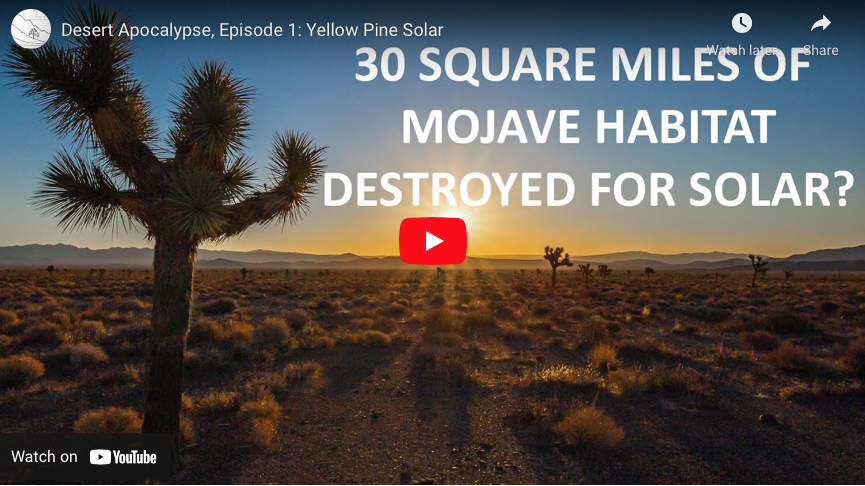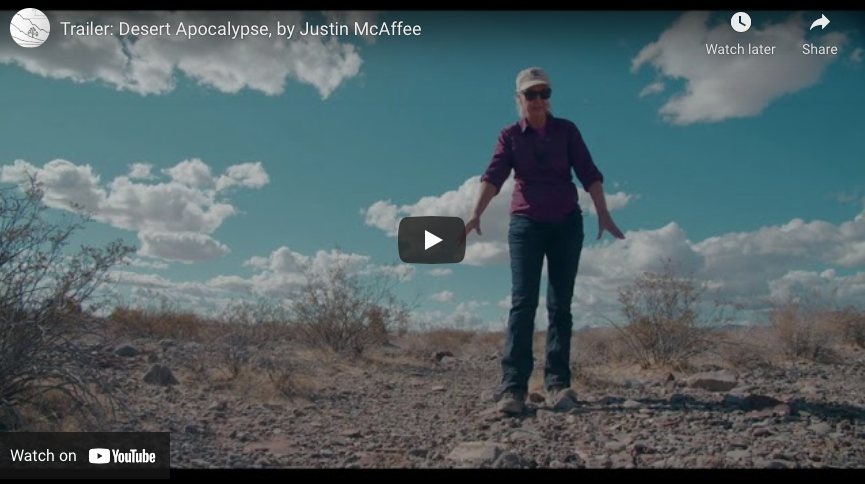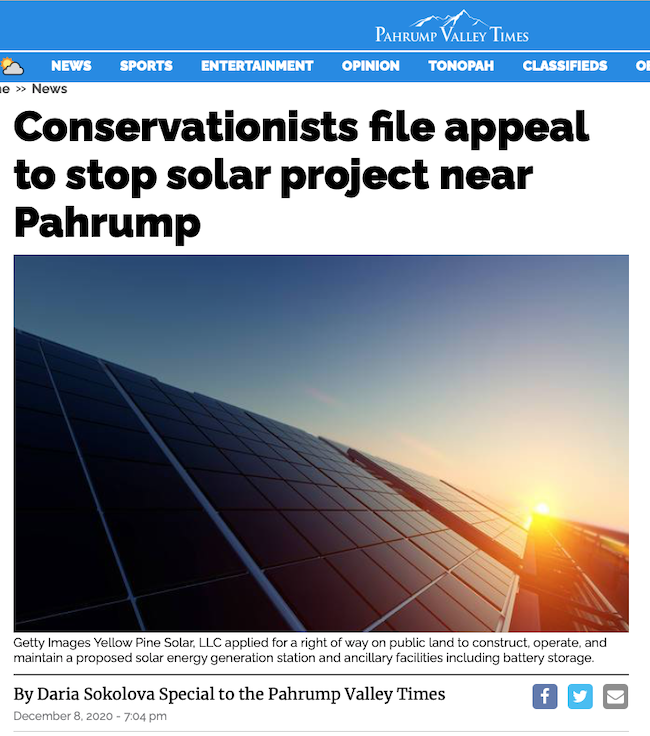Construction Photos
June 16, 2023 - Pahrump, NV - Various photos of the Yellow Pine Solar Project under construction. More photos >>here.
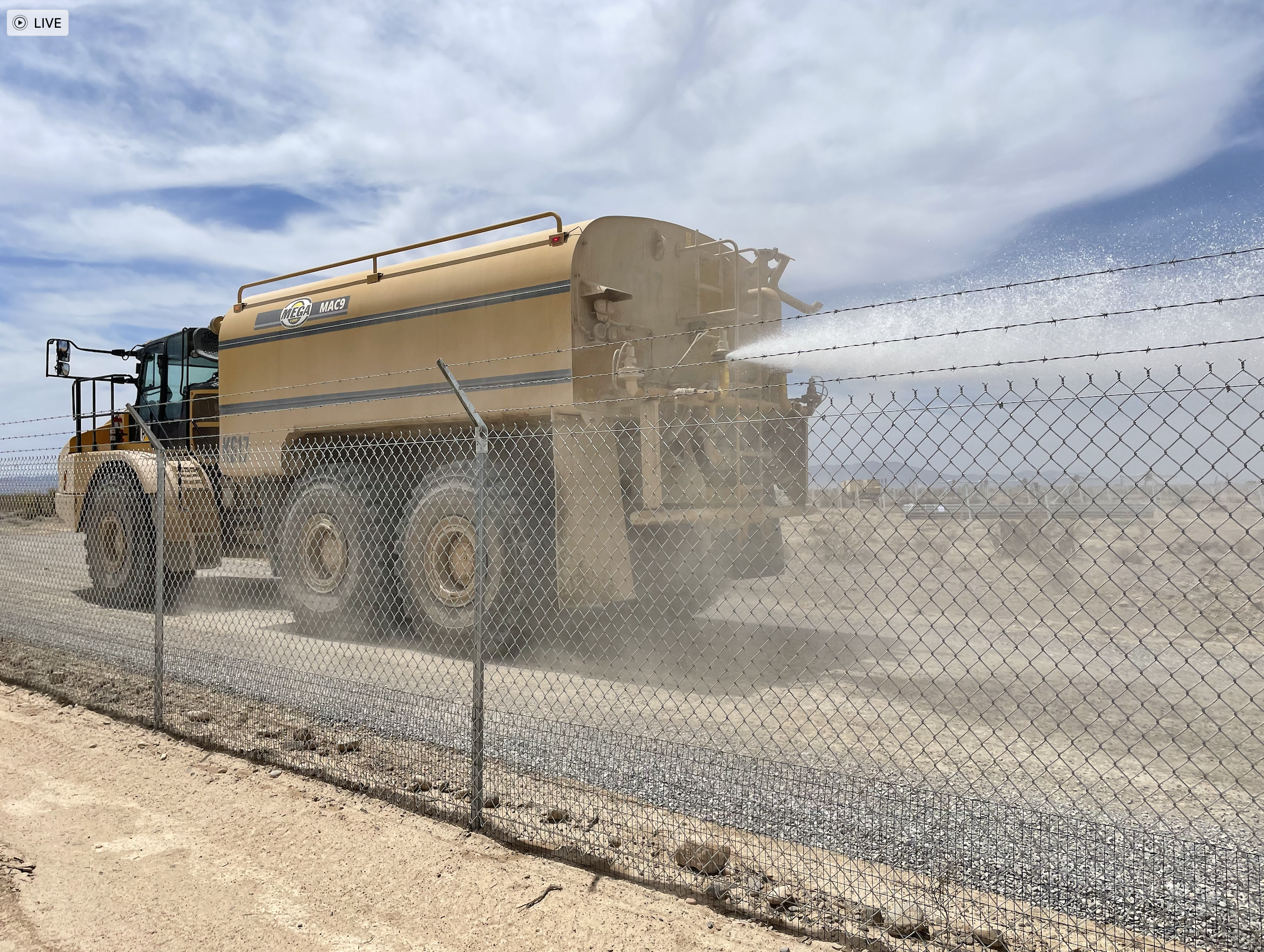
^Water truck spraying a new dirt construction perimter road in the Right of Way, for dust suppression.
Yellow Pine Solar Project Videos by Justin McAffee
August 29, 2021 - Pahrump Valley, NV - Filmmaker Justin McAffee travels with Basin and Range Watch to explore what's at stake at the Yellow Pine Solar project site in Pahrump Valley. They discover thousands of old-growth yucca and the endangered desert tortoise, among countless other species in the Mojave Desert that are threatened here and throughout thousands of square miles in Nevada. https://youtu.be/3xTv20sbVEU
Trailer for the film series Desert Apocalypse: A utility-scale solar project under construction in Nevada has a dirty secret. Watch more of Laura Cunningham, Co-Founder of Basin & Range Watch explain how the Mojave Desert here is being impacted.https://youtu.be/SnpRnSh7cxg
Stay tuned for more films by Justin McAffee in the series: Desert Apocalypse.
Tortoise Translocation Die Off!
July 7, 2021, South Pahrump Valley, NV -
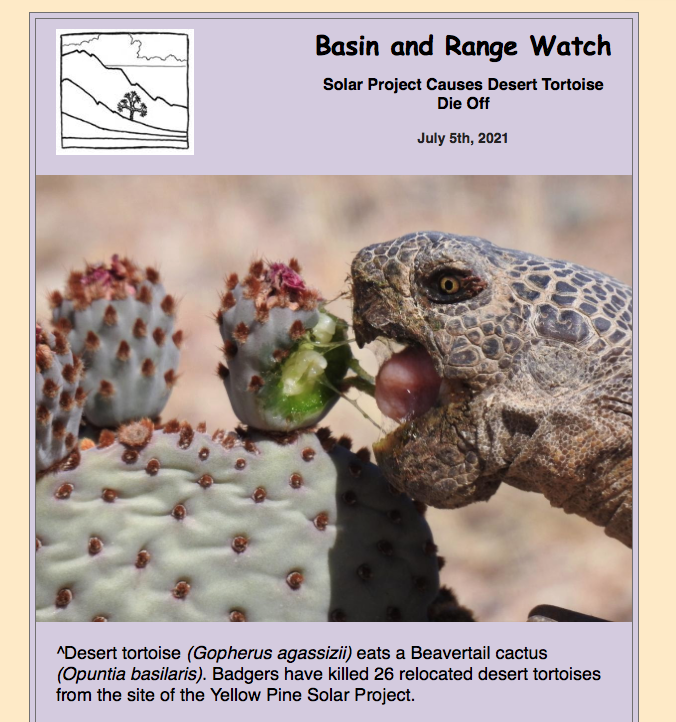

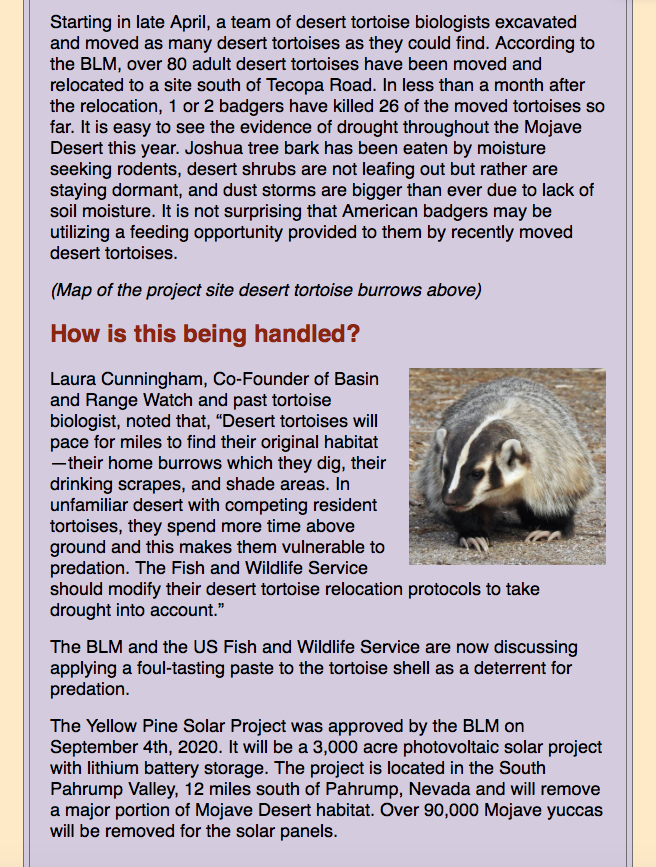
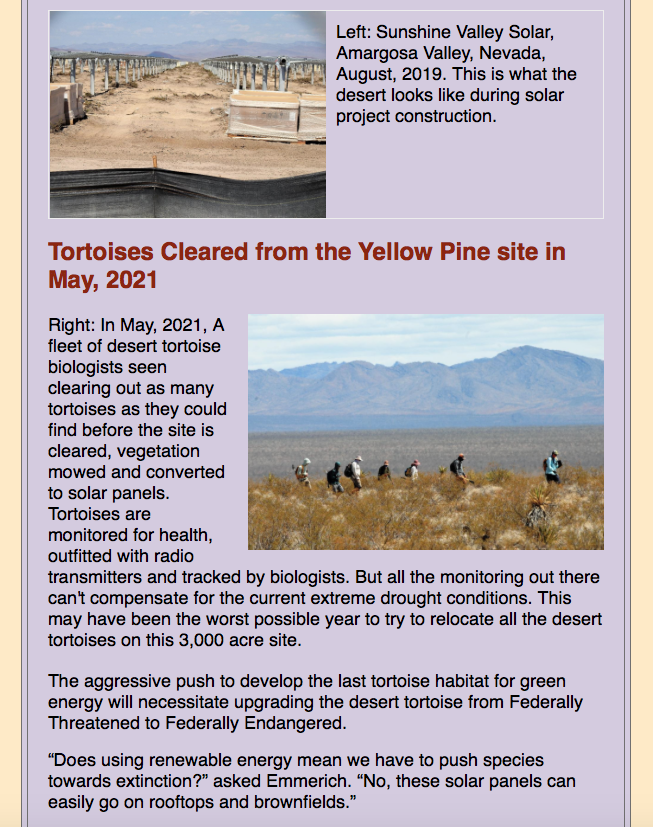
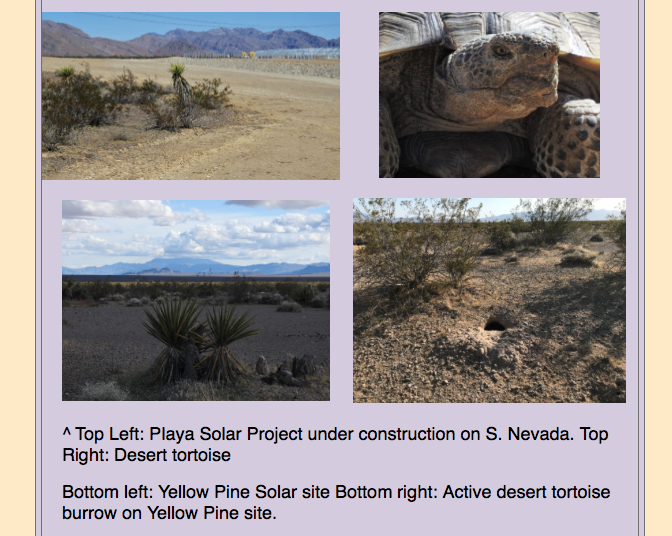
Basin and Range Watch Files an Appeal to Stop Yellow Pine Solar Project
December 10, 2020 - Pahrump NV - The Pahrump Valley Times wrote an excellent article about our appeal to stop the destruction of over 90,000 Mojave yuccas on prime desert tortoise habitat in south Pahrump Valley, Nevada.
https://pvtimes.com/news/conservationists-file-appeal-to-stop-solar-project-near-pahrump-93326/
^Mojave yucca garden at proposed site of the Yellow Pine Solar Project.
Yellow Pine Solar Project Approved and New De Facto Solar Energy Zone in South Pahrump Valley
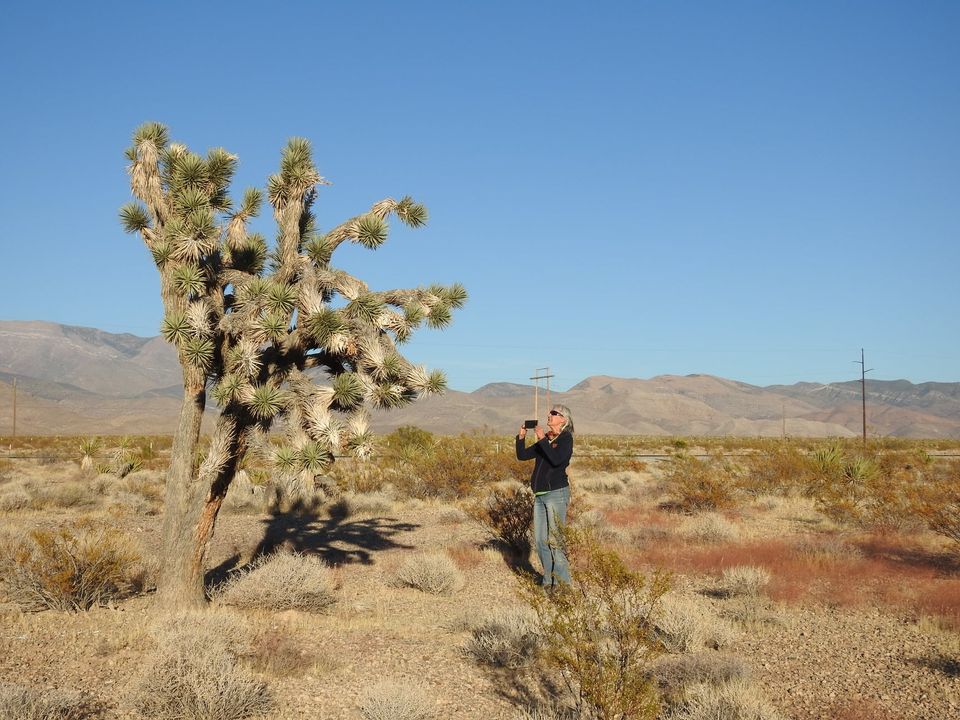
November 6, 2020 - Pahrump NV - The Bureau of Land Management (BLM) approved the Yellow Pine Solar Project On November 6, 2020. Impacts to desert tortoise, over 80,000 Mojave yuccas, desert pavement and old soil crust will not be adequately mitigated. Basin and Range Watch will appeal the decision.
But several new applications surrounding the Yellow Pine project, on equally pristine Mojave Desert, call into question the entire process of the Solar Programmatic environmental review of years ago where solar developers were supposed to be incentived to build in supposedly lower value Solar Energy Zones. No Solar Energy Zone exists in Pahrump Valley, yet developers are flocking here because of the availability of existing high-voltage transmission lines.
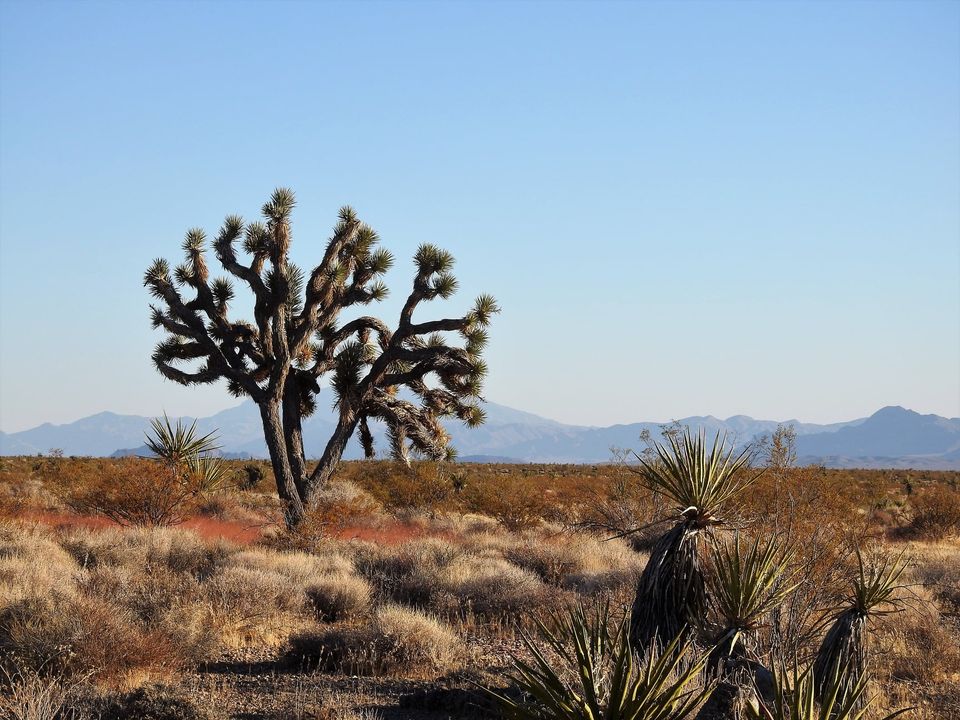
Joshua trees located in South Pahrump Valley on the 2,400 acre site of the proposed Rough Hat Solar Project. This is about 3,300 feet in elevation. The Bureau of Land Management is revieing 4 major solar projects on this habitat. We believe that the projects combined will destroy a half million Mojave yuccas and about 20,000 Joshua trees. The region is being recommended for a new Solar Energy Zone by 4 environmental organizations. More information here: http://clearinghouse.nv.gov/public/Notice/2020/E2020-108.pdf
Three new solar projects are now under review by the Bureau of Land Management in the south Pahrump Valley, Mojave Desert, Nevada. Copper Rays Solar, and Rough Hat Solar in two units. Desert tortoise, Joshua trees, Mojave yuccas on 10,000 acres next to the Yellow Pine Solar Project about to be approved at 3,000 acres. Mojave desert ecosystems expendeble. That will be about 13,000 acres and nearly half a million Mojave yuccas removed. Still getting a count on the Joshua trees. Info on the projects can be found on this link: http://pucweb1.state.nv.us/PUC2/DktDetail.aspx
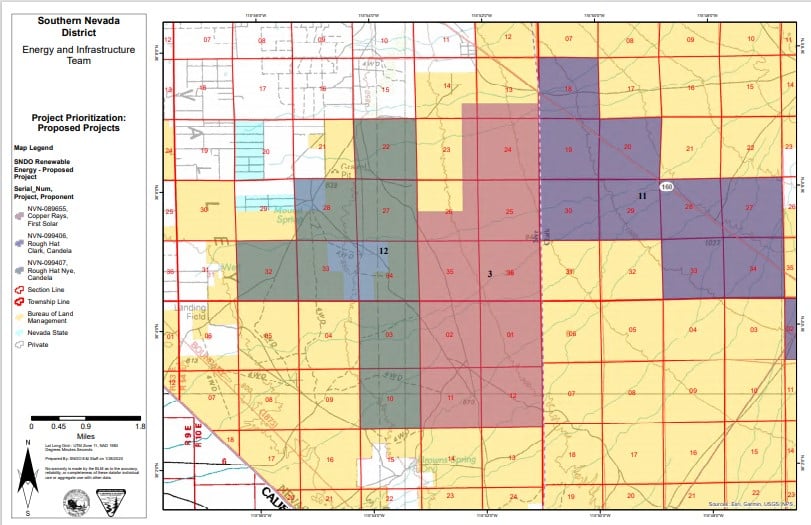
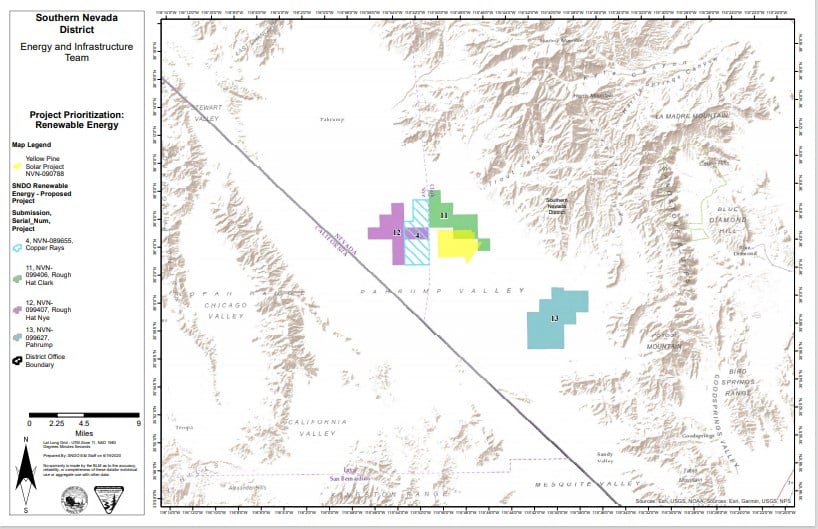
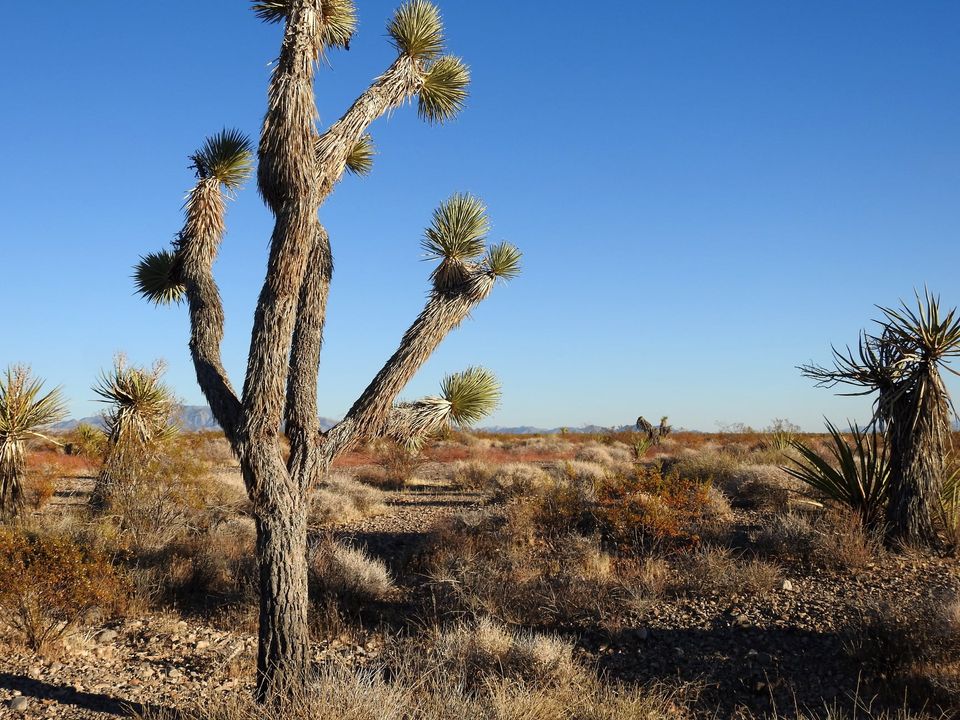
^Western Joshua trees are petitioned to be listed under the California Endangered Species Act, yet in Nevada they receive little protection. Most will be bulldozed and piled like trash to make way for these utility-scale solar projects.
Another new huge solar application for the Mojave Desert: The Sagittarius Solar Project would be built on 4,300 acres of BLM land about five miles Southeast of Pahrump, Nevada. It would need to go east of Highway 160 up the alluvial fan and yes, this one will be obstructed by a host of all those other pesky Mojave Desert species that are so burdensome to solar developers. Joshua trees, kangaroo rats, desert tortoise, kit fox, Mojave yuccas - you get the idea. Along with Yellow Pine Solar, Rough Hat Solar, and Copper Rays Solar, a total of 17,000 acres of old growth Mojave Desert are being planned for development for large-scale solar in this area. Ricardo Graf, the owner of Gemini Solar appears to also own this company, Noble Energy - follow the money.
Notice by Noble Solar LLC, under the provisions of the Utility Environmental Protection Act, of an application to a federal agency for approval to construct the Sagittarius Solar Project consisting of a 400 MW photovoltaic solar electric generating facility, a 400 MW battery energy storage system, and associated facilities to be located in Nye and Clark Counties, Nevada:
http://pucweb1.state.nv.us/…/DOCKETS_2020_…/2020-11/5817.pdf
Adjacent Rail Storage Project Breaks Ground
We are happy to see that this project was moved off of public lands onto a disturbed site. It was going to cut through Joshua tree habitat in Carpenter Canyon. BLM estimated over 4,000 Joshua trees would have been removed. We were the only group that raised concerns. About 8 years ago, very few environmental organizations objected to Joshua trees being removed for renewable energy projects.
Final Environmental Impact Statement Out For Yellow Pine Solar Project

^The Yellow Pine Solar Project site is full of Mojave yuccas that will be destroyed to make way for a solar field. Snowy Spring Range in the background.
September 4, 2020 - South Pahrump Valley, NV - Today the Bureau of Land Management (BLM) released its Final Environmental Impact Statement (EIS) that proposes to develop over 3,000 acres of prime Mojave Desert habitat and shred over 80,000 unwanted Mojave yuccas currently thriving on the site.
Here is the BLM site: https://eplanning.blm.gov/eplanning-ui/project/81665/510
Public comments are overwhelmingly in opposition to developing an energy sprawl project here. More on this project soon. We will be appealing this project and trying to conserve our non-renewable public lands.
Take Action!
June 20, 2020 - What you can do and who to write letters to, opposing utility-scale solar project construction on this senstive desert ecosystem on public lands >>here.
Summer Solstice Live Zoom Field Trip to the Yellow Pine Solar Site
June 20, 2020 - Basin and Range Watch and Amargosa Conservancy are hosting a live field trip today out on the proposed solar project construction site. Thank you for caring. We will learn all about the plant and animal life of the area, biological soil crusts, and the threats that face this beautiful and remote Mojave Desert valley.
Topic: Summer Solstice Yellow Pine Solar Site Visit
Time: Jun 20, 2020 06:00 PM Pacific Time (US and Canada)
Join Zoom Meeting
https://us02web.zoom.us/j/85834448659
Meeting ID: 858 3444 8659
One tap mobile
+16699009128,,85834448659# US (San Jose)
+12532158782,,85834448659# US (Tacoma)
Dial by your location
+1 669 900 9128 US (San Jose)
+1 253 215 8782 US (Tacoma)
+1 346 248 7799 US (Houston)
+1 646 558 8656 US (New York)
+1 301 715 8592 US (Germantown)
+1 312 626 6799 US (Chicago)
Meeting ID: 858 3444 8659
Find your local number: https://us02web.zoom.us/u/kdzj223Md6
A few notes for our Zoom meeting:
1. Please keep yourself on mute to avoid excess background noise. The hosts may mute everyone in the viewing audience until question and answer time.
2. If you have a question or a comment click the "Raise Your Hand" button on Zoom. We will have allotted sections for questions.
3. You can also write in questions on the Chat comment box on Zoom and we will answer your questions when we can.
COVID-19 Times, Yet Interior Barges Ahead With Solar-Sprawl Projects on Desert Full Steam Ahead
^In Early May 2020, lilac sunbonnets (Langloisia setosissima) sprinkled across the alluvial desert floor on the site of the proposed Yellow Pine Solar Facility.
May 8, 2020 - Pahrump Valley, Clark County NV - Basin and Range Watch submitted comments on Bureau of Land Management's Draft Environmental Impact Statement (EIS), which closed on May 4, 2020. We found many deficiencies in the analysis, including a lack of proper--or any--detailed discussion of mitigation measures, and a poor review of Visual Resources. The mitigation seems to be to shift the project north of the Tecopa Highway and call it done.
Despite the fact that 90,000 Mojave yuccas grow on the proposes solar project site, and are proposed to be mulched, bulldozed, mowed, and graded down to make way for photovoltaic panels which should go over parking lots and rooftops in already-developed areas.

^Mojave yuccas and desert pavement of packed limestone gravel, Pahrump Valley, Nevada. Site of the proposed Yellow Pine Solar facility.
-
Yellow Pine Solar, LLC has applied for a right-of-way on public land to construct, operate, and maintain a proposed solar energy generation station and ancillary facilities including battery storage, known as the Yellow Pine Solar Facility. Second, GridLiance West, LLC has applied for a right-of-way (ROW) on public land to construct, operate, and maintain a GridLiance West 230-kilovolt (kV) Trout Canyon Substation and associated 230-kV transmission line. These two applications are collectively known as the Yellow Pine Solar Project.
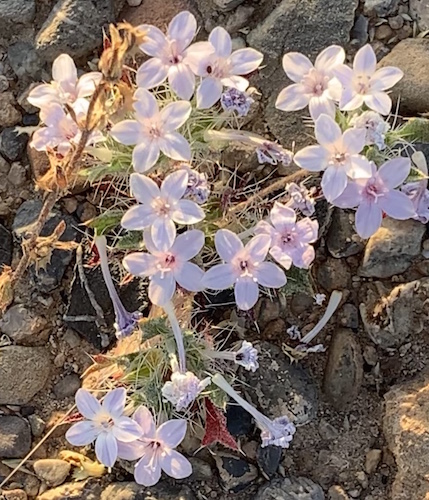
^Lilac sunbonnets blooming abundantly this spring after heavy late season rains.
^Site of proposed Yellow Pine Solar Faciylyt, which would bulldoze this undisturbed Mojave Desert landscape. If you look closely, you can see the abundant tiny lilac sunbonnets sprinkled all over the ground. Kingston Range in the background.
The proposed Yellow Pine Solar Project is located approximately 10 miles southeast of Pahrump and approximately 32 miles west of Las Vegas in Clark County, Nevada. The Yellow Pine Solar Project would be located on approximately 3,072 acres of BLM managed public land.
The Bureau of Land Management (BLM) prefers the Mowing Alternative where vegetation would be maintained at a height of 18 to 24 inches to address concerns related to the loss of topsoil, vegetation, and seedbanks.
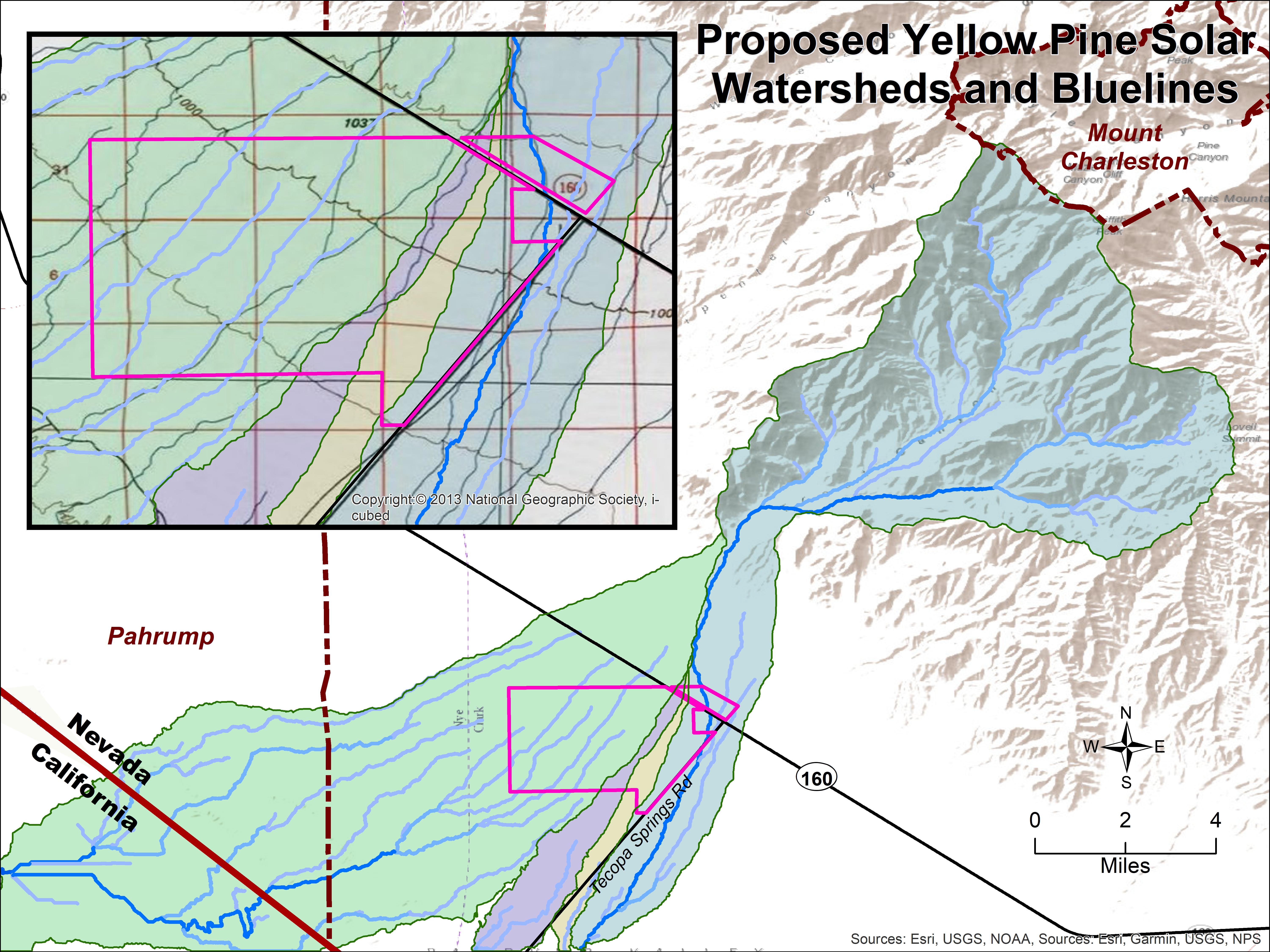
The Proposed Action would be divided into four unique sub-areas to avoid three large washes that cross the study area, according to BLM, yet this map by Brian... show that the entire solar project lies in an active alluvial fan fed by a large snow-melt and storm-fed watershed in the high Spring Range. The draft EIS avoids any discussion of how the project will avoid being damaged by future flash floods and debris flows.

^Lilac sunbonnets and interestingly banded limestone rock on alluvial fan, on the proposed project site.
We requested BLM delay this review during the COVID-19 pandemic, in our comment letter (we were ignored):
It is our understanding that the Southern Nevada district of the BLM did request a comment extension for this review over the Covid-19 crisis. Some of use made that request and we do appreciate the efforts that this office made to meet those requests. Ultimately, we were told that the Interior Secretary said no. He is using the pandemic to streamline this review.
This is very irresponsible. Our organization has several people assisting, some are volunteers and some of them were not able to participate in the narrow time frame of this EIS due to the unique stresses from the crisis. We had our own situation which created problems getting these comments on time. You will most likely miss comments over this. Equally, the Interior Department has eliminated public meetings for this review. It may be legal to eliminate public meetings, but it is unique to do such a thing and this weakens the public’s opportunities to be heard on the issue. We were told by BLM in Reno that this comment period can’t be extended because Yellow Pine has made Fast 41 Status. There is nothing in the Code of Federal Regulations, the Federal Lands Policy Management Act or the National Environmental Policy Act that requires the BLM to eliminate public meetings or prevents the BLM from extending a public comment period. In fact, the BLM has delayed the review of the Gemini SolarProject 3 times. Gemini is also a Fast 41 Project.
Furthermore, the BLM has not really made the case that Yellow Pine is an essential project. In fact, pushing it through like this can further endanger the workers as well as the residents of Pahrump, Nevada and Charleston View, California. This is because those suffering from Covid-19 symptoms are more susceptible to respiratory issues and no large-scale solar project to date in arid regions of the southwest has ever adequately mitigated the fugitive dust caused by construction. Over 25 workers contracted Valley Fever on a solar project in San Luis Obispo County, California.
https://m.lasvegassun.com/news/2020/apr/27/nevada-fight-over-bombing-range-pits-tribes-vs-us/
If someone is Covid – 19 positive, Valley Fever could make their immunity even more compromised and there are not enough tests available.
One other suggestion for the Southern Nevada offices of BLM would be to answer questions directly and not make us go to the state office for answers.
^Laura Cunningham stands next to a tree-like Mojave yucca on the proposed Yellow Pine Solar Facility site. Will this yucca be bulldozed? Or mowed down to 18 inches to accomodate solar panels? This is unacceptable to us. Solar panels belong over parking lits and on rooftops.
Excerpt from E&E Newswire (paywalled) article Solar project highlights 'unprecedented challenge' facing BLM by Scott Streater, quoting Kevin Emmerich, Co-Founder of Basin and Range Watch, on the lack of consideration of the COVID-19 pandemic:
But despite requests for delay, BLM is scheduled to publish the draft environmental impact statement in tomorrow's Federal Register, kicking off a 45-day public comment period running through May 4. Details of the draft EIS are included in a notice in today's Federal Register.
"Holding a full environmental review in the midst of a pandemic is nothing short of irresponsible," Kevin Emmerich, co-founder of the Nevada-based group Basin and Range Watch, said in a statement to E&E News. "The State of Nevada has closed down all non-essential business for 30 days in light of the COVID-19 crisis. How can the BLM expect to get the normal range of public comments in this situation?"
Emmerich shared several emails with E&E News that he received this week from top BLM Nevada officials. They provide insight into the difficulties the bureau is facing during the pandemic.
Emmerich on Tuesday sent an email asking Shonna Dooman, the manager of BLM's Las Vegas Field Office, to postpone release of the draft EIS for the Yellow Pine project for two months "until we can get a better handle on this crisis."
Herman Pinales, BLM Nevada's energy and infrastructure project manager, wrote in an email to Emmerich yesterday that the bureau is "in the early stages of trying to see if we can do [a] virtual open house" for public comment on the draft EIS. Pinales wrote that they "hope to have an answer in the next couple of weeks."
Emmerich responded that, in his opinion, even this step would fail to "compensate for all the disruption and unemployment that has been caused by Covid-19."
BLM Nevada Director Jon Raby wrote Emmerich yesterday thanking him for his comments and promising to address his concerns.
"We are well aware of the situation and responding accordingly," Raby wrote. "Please be patient as we all work through the challenges of this unprecedented challenge."
Conservation groups and other advocates have been pressuring BLM to delay activities like oil and gas lease sales, as well as completing environmental reviews of large projects or revising regulations such as those governing livestock grazing on federal rangelands, during the pandemic (E&E News PM, March 18).
But BLM has said it has no plans to do so (Greenwire, March 17).
Meanwhile, the Yellow Pine Solar Project, proposed by a subsidiary of NextEra Energy Resources LLC, moves forward.
Dooman, in an email to Emmerich, said BLM plans to publish the draft EIS tomorrow.
"We are aware of our inability to hold in-person public meetings in the current conditions. As Herman mentioned, we are evaluating other options," Dooman wrote.
"Continuing our service to the public while doing our part to address COVID-19 is very important," she added. "We are also in early discussions about a potential extension on the review period. If we proceed with this, we will determine the amount of time to extend based on where we are in the review period and what the public situation is at the time."
The Yellow Pine project is one of a handful of large-scale solar and wind projects that BLM wants to finalize this year as part of President Trump's "energy dominance" campaign that, to date, has mostly focused on oil and gas development (Greenwire, Jan. 2).
BLM is aiming to issue a final EIS for Yellow Pine this summer, followed by a record of decision approving it this fall.
Visual Resources are not fully addressed
Key Observation Point Simulations: There are none in the DEIS or appendices! It appears that the BLM just forgot to include these. It is impossible to submit substantive comments on visual resource KOP without being able to see them. The DEIS says 11 KOP’s were created. Again, a proper review of this project will need a supplemental EIS.
The Desert Tortoise Recovery Plan:
Yellow Pine Solar will have a major impact on the threatened desert tortoise. A Recovery Plan for the tortoise was written in 1994 and updated in 2011.
A "recovery plan" determines the "threats" that are hurting the species, suggests actions that will reduce or eliminate these threats so species can fully recover, and recommends ways to ensure that the population remains stable.
The goal of the Endangered Species Act (ESA) is to conserve the ecosystems upon which listed species depend and to recover species to levels where protection under the ESA is no longer necessary. Section 4 of the ESA directs the Service to develop recovery plans for the conservation and survival of a listed species.
Key elements of the revised plan include the following:
Develop, support, and build partnerships to facilitate recovery;
Protect existing populations and habitat, instituting habitat restoration where necessary; Augment depleted populations in a strategic, experimental manner;
Monitor progress toward recovery, including population trend and effectiveness monitoring;
Conduct applied research and modeling in support of recovery efforts within a strategic framework; and implement a formal adaptive management program that integrates new information and utilizes conceptual models that link management actions to predicted responses by Mojave desert tortoise populations or their habitat.
The DEIS fails to integrate new information about drastic declines in most Recovery Units of the Mojave Desert tortoise in the last 10 years. We discuss more about these details of desert tortoise declines below.
Moving Yellow Pine Solar Project to North Side of Tecopa Highway Will NOT Lessen Impacts to Desert Tortoise

^New map of the project, moved to the north side of the Tecopa Highway where we found a desert tortoise.
March 3, 2019 - Pahrump Valley NV - The Bureau of Land Management will release the Draft Environmental Impact Statement for the Yellow Pine Solar Project in mid-April. This will be a 3,000 acre photovoltaic project located in the South Pahrump Valley, Nevada on pristine, Mojave Desert habitat for rooftop friendly solar panels. It is very good desert tortoise habitat. Combined with the proposed Gemini Solar Project to the south, the BLM is about to approve the removal of 10,000 acres of desert tortoise habitat. The region is recovering from a drought, so the tortoise count is not as high as Gemini. They found 53 on the survey. But the US Fish and Wildlife Service has identified the site as one of the last important in tact desert tortoise connectivity sites in the Mojave Desert. A 4.6 square mile solar project will change this. The BLM tells us that all Joshua trees and Mojave yuccas on the site will be shredded and mulched. The original application was 9,000 acres. The project will be built right next to a new desert tortoise translocation area. This area was put aside to relocate tortoises from other development projects. The project will be built next to and be visible from the Old Spanish Trail. The BLM and one environmental organization are trying to spin this by saying the habitat is not as important on the NW side of Tecopa Road. Trust us - that is bullshit. More information here:
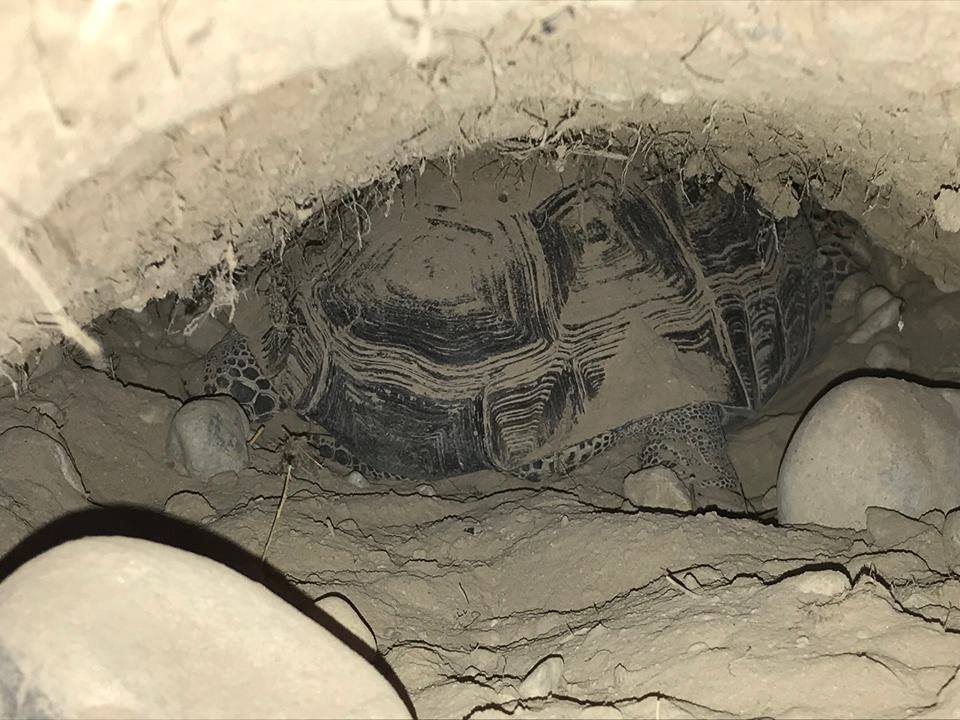
^Large healthy desert tortoise in its burrow on the north side of the Tecopa Highway, where several environmental organizations are accepting "mitigating" the project impacts by moving the solar field to this side. We are not all right with moving the solar project to the north side of the highway, as this desert tortoise will now have to be dug out of this burrow and transloacted somewhere else, risking mrotality from predation or hyperthermia.

^The richly biodiverse Mojave Desert scrub below the Spring Range, with Mojave yuccas. This is the north side of the Yellow Pine Project, where many stakeholders have agreed to move the project to "lessen impacts." We disagree that impacts will be lessened, and oppose any part of this desert being bulldozed.
The Mojave Desert: Unneccesary Sacrifice of Wildlands and Biodiversity
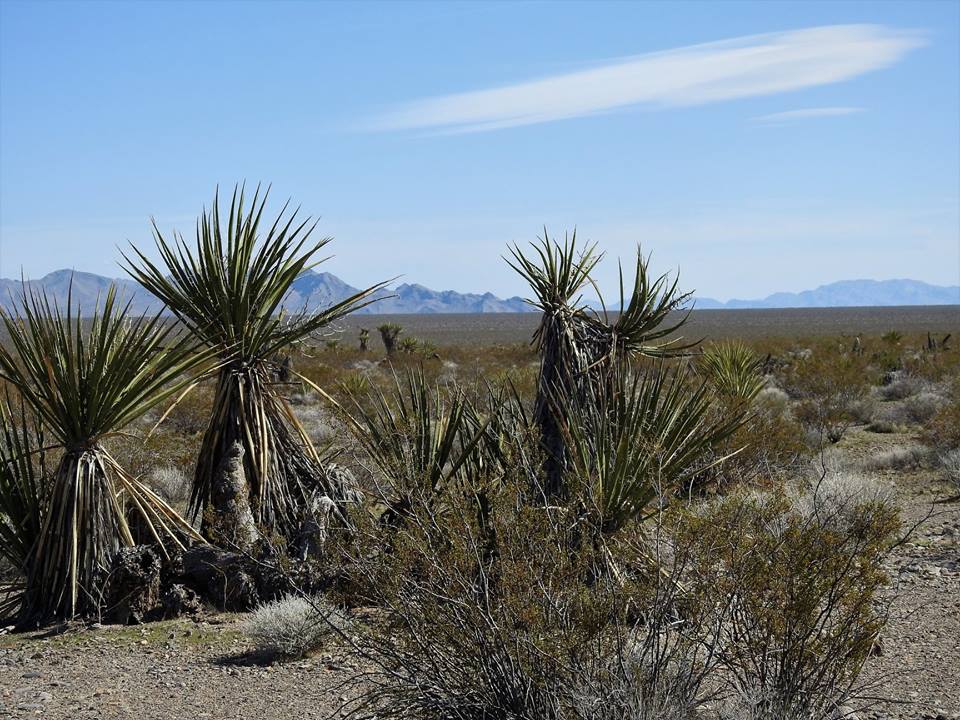
BEFORE
July 14, 2018 - Pahrump Valley NV - Why does the Mojave Desert not matter anymore when high biodiversity and public lands are at stake? Why after ten years of fighting CO2 emissions have more organizations and politicians not embraced rooftop solar, energy effieicny, and Distributed Energy Resources as the best way to combat climate change without the huge impacts to ecosystems that utility-scale solar projects have on the environment?
Question 6 on the Nevada ballot should increase rooftop solar and distributed battery storage towards the 50% Renewable Energy Portfolio Standard, and not sacrifice more public land Mojave Desert ecosystems. The desert tortoise continues to decline, we are losing wildlands crucial to eco-tourism in the desert, and we are ignoring the easiest, least-cost solution to climate change: solar in the built environment free of the need for long transmission lines and bulldozers on desert lands that release CO2 from destroyed vegetation and biological soil crusts.
The first photo above is Bureau of Land Management (BLM) land in the southern Pahrump Valley, Mojave Desert, Nevada, along the Old Spanish Trail Highway. Nextera Energy wants to build the Yellow Pine Solar Project on 3,000 acres of this good quality habitat for the desert tortoise.
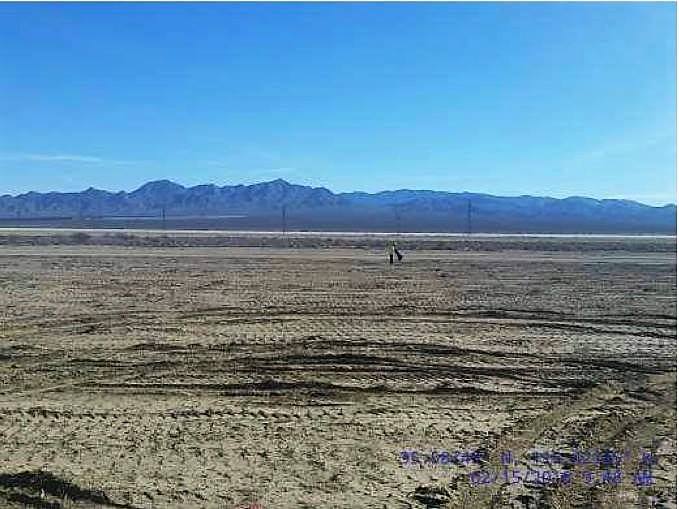
AFTER
The second photo is the 2014 construction of the Stateline Solar Project located on BLM land in the Ivanpah Valley, California. Every living organism was either obliterated or moved out of the way. While new buildings are being constructed in Las Vegas everyday, BLM still will probably approve the destruction of 4 square miles of desert for solar panels that do very well on rooftops.
Bureau of Land Management Scoping Meeting on Yellow Pine Solar Project
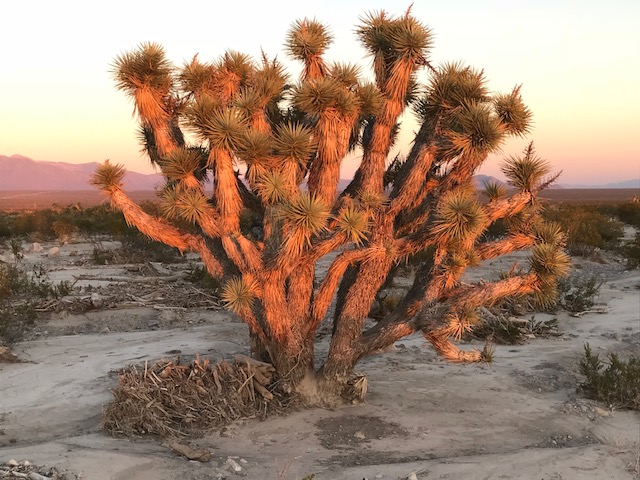
^Joshua tree on the proposed site of the utlity-scale solar project. This will be chipped and mulched.
July 1, 2018 - Pahrump, Nevada - Basin & Range Watch attended a Bureau of Land Management (BLM) scoping meeting for the Yellow Pine Solar Project last Wednesday – a 3,000 acre photovoltaic facility which would be built on good quality Mojave Desert habitat for the federally threatened desert tortoise. We were informed by the BLM that it is too expensive to salvage or transplant the thousands of Mojave Yuccas and Joshua trees on the site. These plants, many hundreds of years old, will all be shredded and mulched. We believe that the site is very inappropriate for solar panels. Nearby Las Vegas is expanding and destroying Mojave Desert habitat on an expedited basis and has plenty of room for solar panels in developed areas. But developer Nextera, a multi- billion dollar company, will not try to find private lands for this project which would be available in the Las Vegas and Pahrump Valleys and will not salvage the thousands of old growth desert plants they will destroy. BLM is apparently not interested in requiring them to do so as a mitigation.
^Desert horned lizard at sunset on the proposed project site.
The Joshua trees and Mojave yuccas will go in the shredder, lizards will be crushed, and desert tortoise will be excavated and moved – all for solar panels that don’t care if they go on a rooftop. Comments due on August 30th.
And the BLM project website here: https://eplanning.blm.gov/epl-front-office/eplanning/planAndProjectSite.do?methodName=dispatchToPatternPage¤tPageId=122115
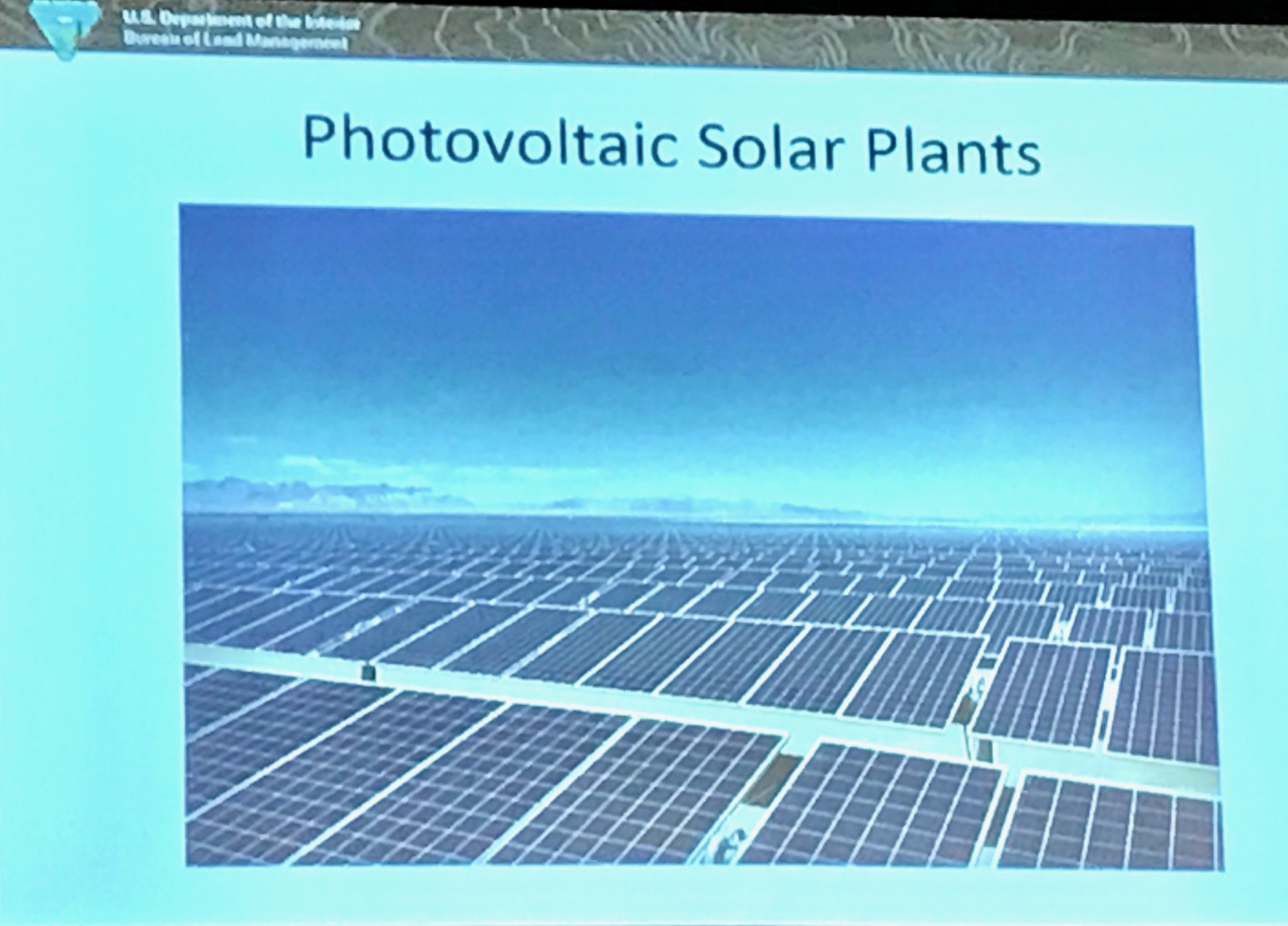
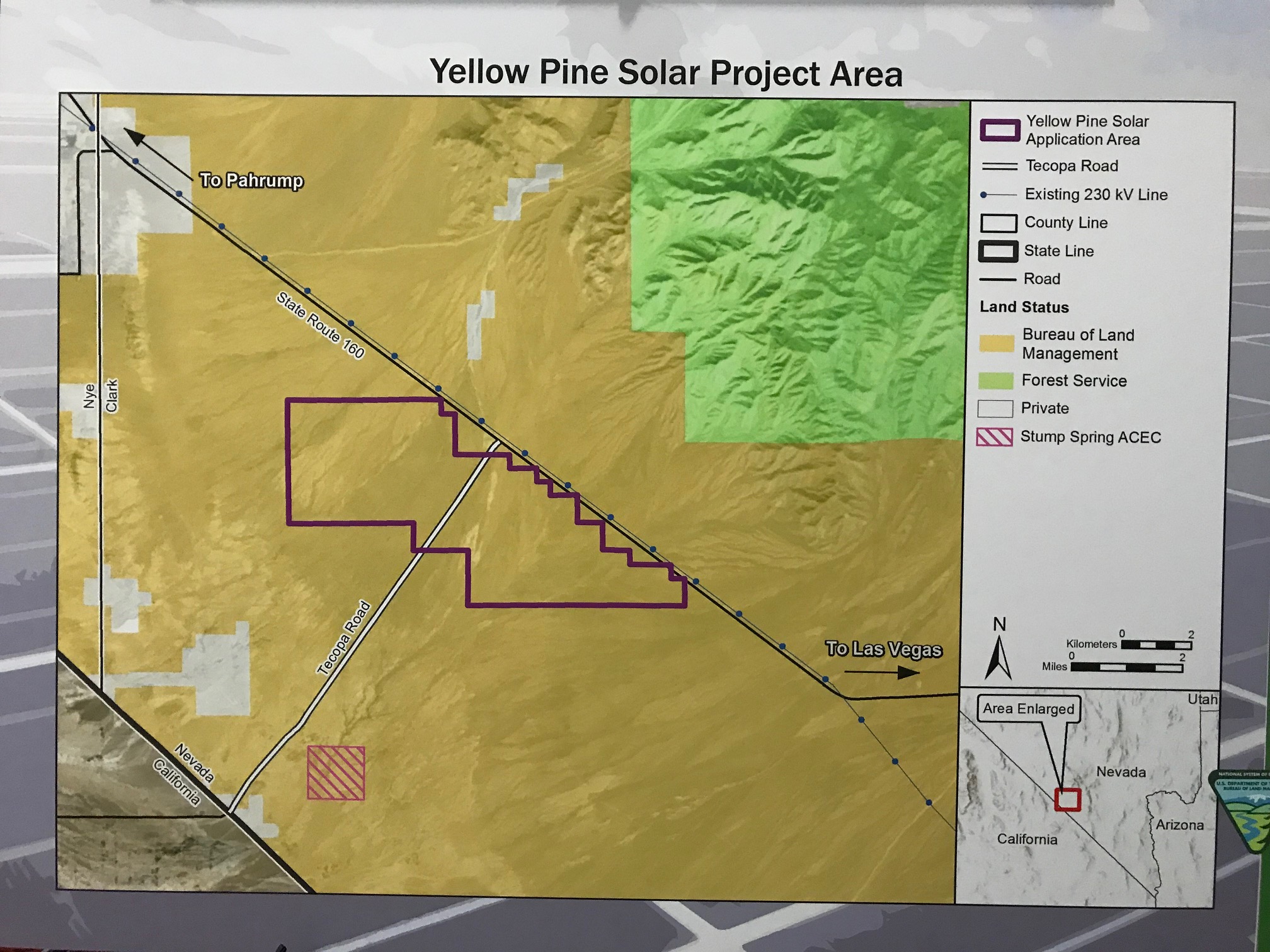
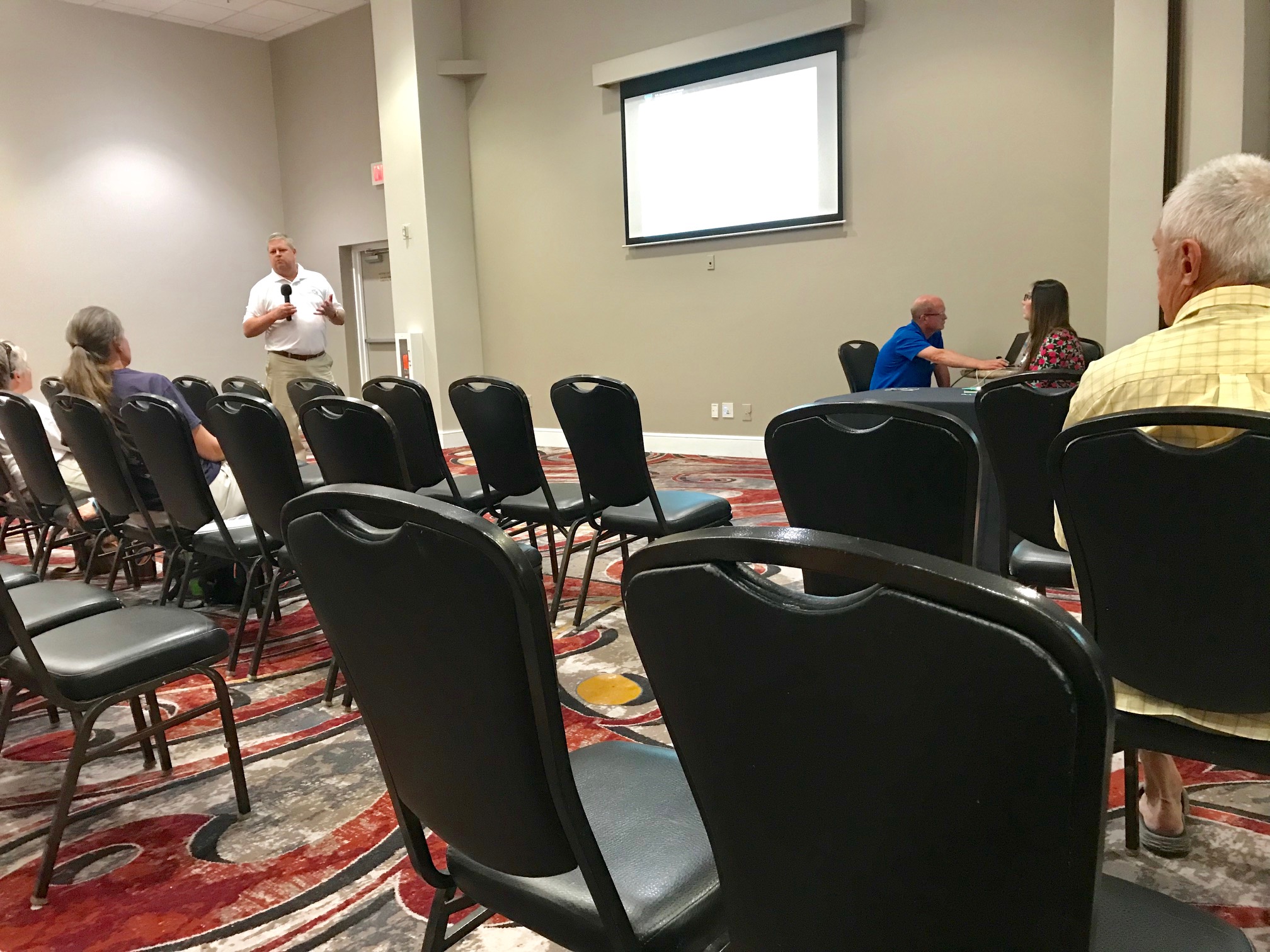
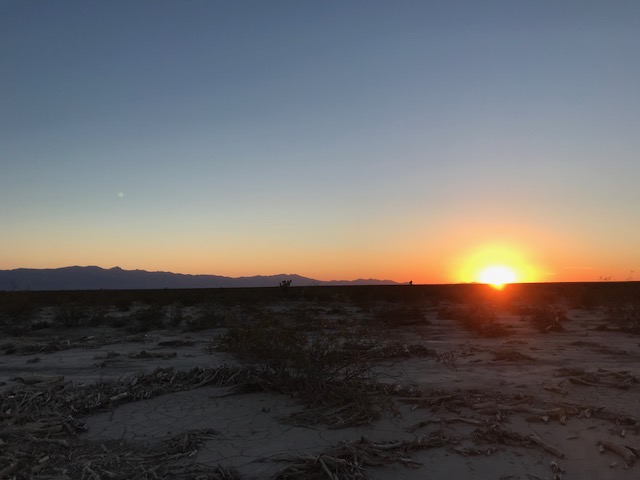

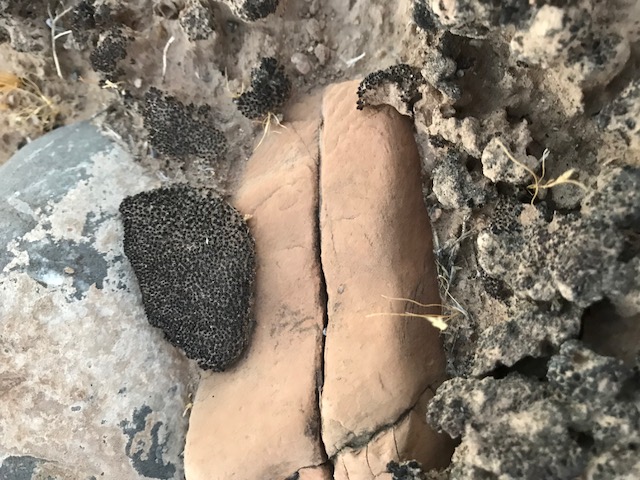
^Mossy biological soil crsut is common on the proposed solar project site. These will be driven over and crushed, disturbed by construction and maintenance.
Yellow Pine Solar Project in Southern Nevada Starts Review
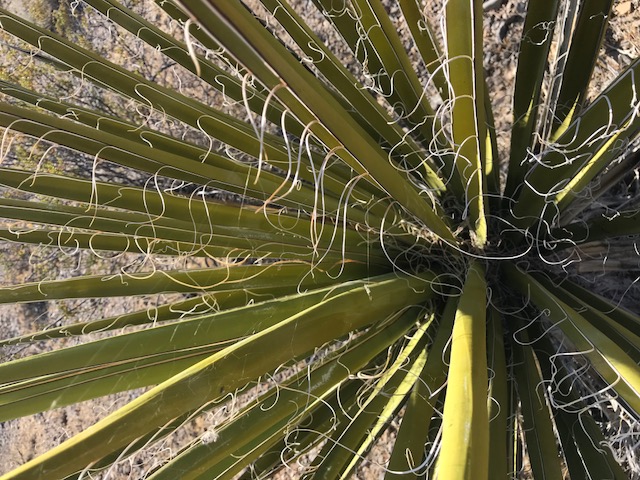
^Mojave yucca on the footprint of the proposed solar project.
June 2, 2018 - South Pahrump Valley NV - The Notice of Intent is now officially in the Federal Register for the Yellow Pine Solar Project – a 2,500 acre to 3,000 acre photovoltaic facility with integrated battery storage on BLM lands, with a Right of Way of over 9,000 acres. The project will be located in Nevada, near the California border in the southern Pahrump Valley. It will be on top of the Old Spanish Trail, next to the Stump Spring Area of Critical Environmental Concern and visible along the Hwy 160 and the Tecopa Road/Old Spanish Trail turn off. The project will also be visible from California Wilderness areas like the Kingston Range. It will be developed in the recently approved Stump Spring Desert Tortoise Translocation Area – designated to place displaced tortoises from other development regions. The actual translocation area is larger than the solar project, but we do not approve of bulldozing a recently established recovery habitat for a species. We visited the site on Bureau of Land Management land last week and found a healthy large adult tortoise on the project footprint, as well as a host of other species. Two fledgling Black-throated sparrows were seen, indicating a good spring for bird nesting here. Plan of Development for the Yellow Pine Solar Project.
Here is the federal register notice:
This is a good article in the Spectrum out of St. George, Utah, about the growing cumulative impacts to the desert tortoise across its range which concerns the Desert Tortoise Council:
This article in the Nevada Independent quotes us, but also has a questionable statement by NextEra, the project applicant saying that the project does not overlap with the pre-existing tortoise translocation area. From our maps (see below on this page), they appear to us to overlap. But we will wait to see if BLM updated and changed the project footprint to be outside of the designated translocation area.
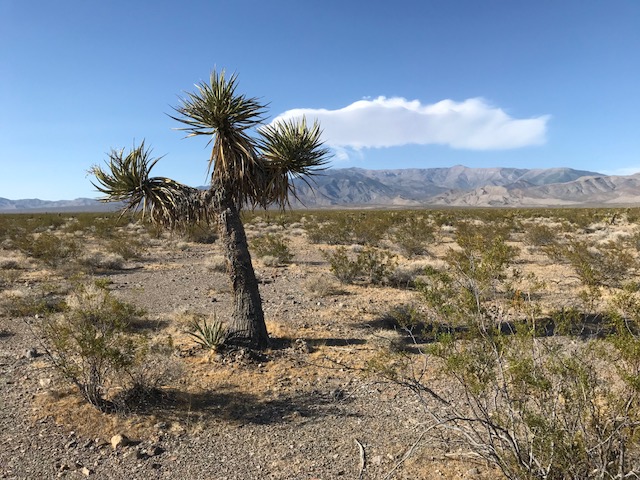
^Tall tree-like Mojave yucca (Yucca schidigera) on the poposed project site.

^Cottontop cactus (Echinocactus polycephalus) on the proposed project site.
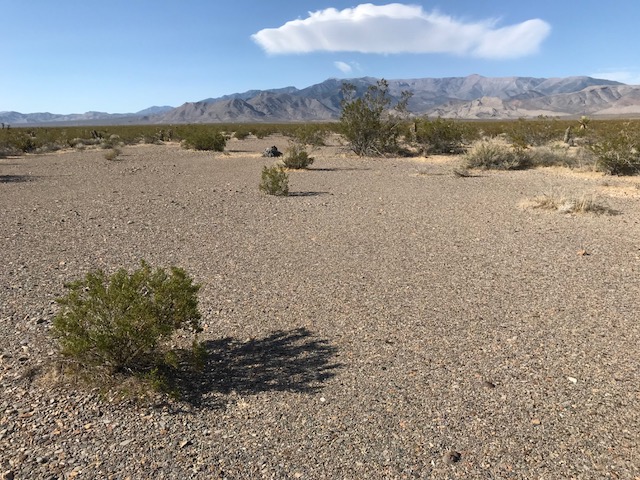
^A beautiful example of natural desert pavement, and this area also appears that it holds a thin sheet or rainwater at times, as the creosote bushes along the edges have grown tall and lush. The enormous desert tortoise burrow was also on the edge of this--the tortoise may benefit too from the ephemeral rain-holding desert pavement.
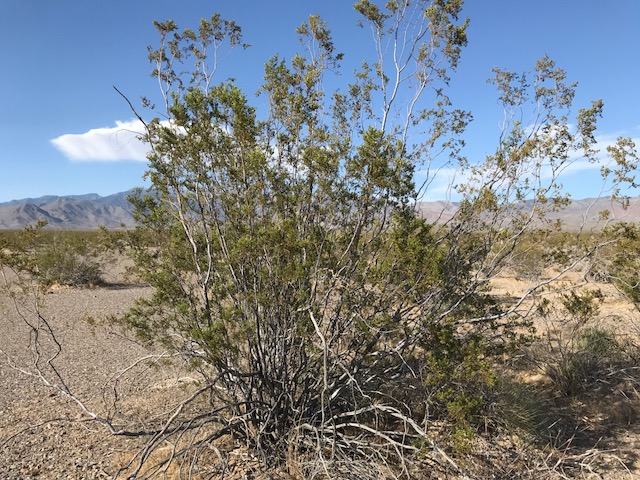
^Tall lush creosote bush (Larrea tridentata) on the edge of natural desert pavement.
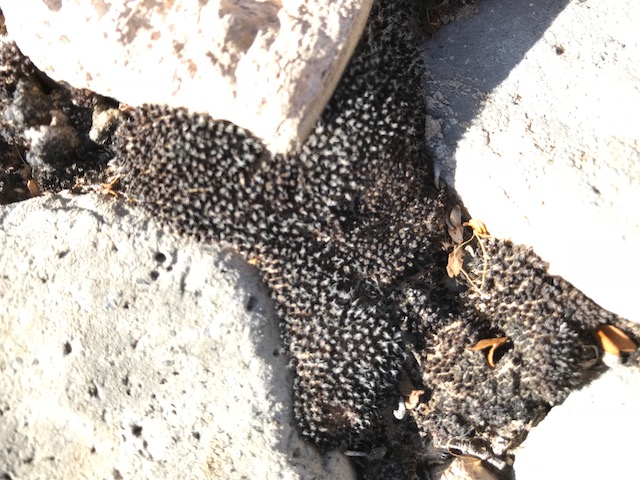
^Moss in the rocks of the desert.
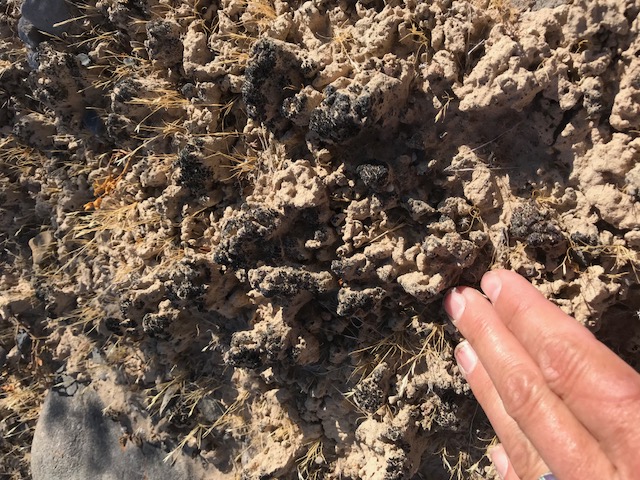
^Prisitne untrampled biological soil crust compoaed of alge, lichen, and moss, on the proposed solar project site. This living crust greens up with rainwater, and sequesters Carbon. So why are we bulldozing it in the fight to lower greenhouse gas emissions?
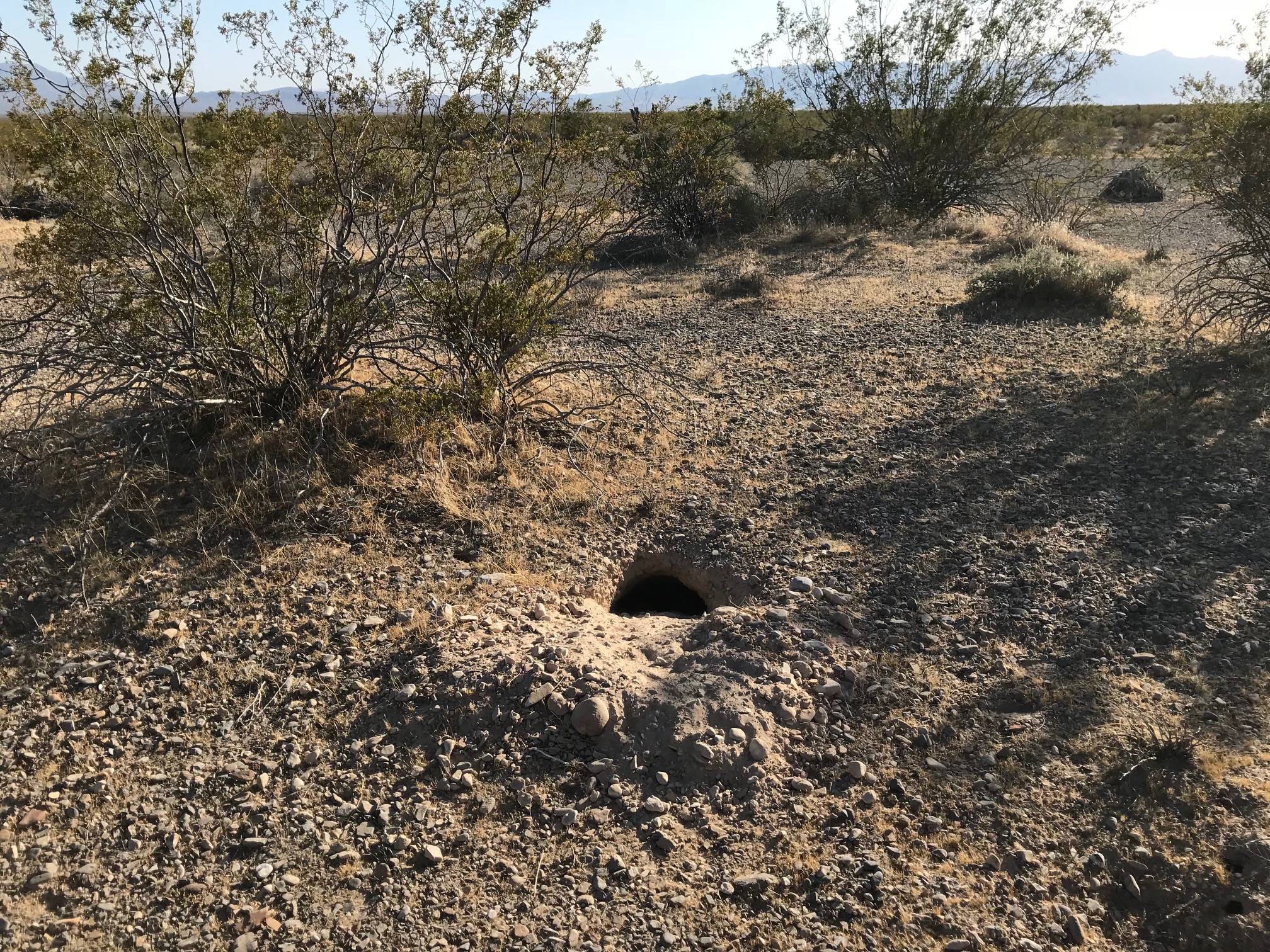
^A very large active desert tortoise burrow, on the proposed project site. This old tortoise will have to be dug out of its burrow and translocated, risking mortality.
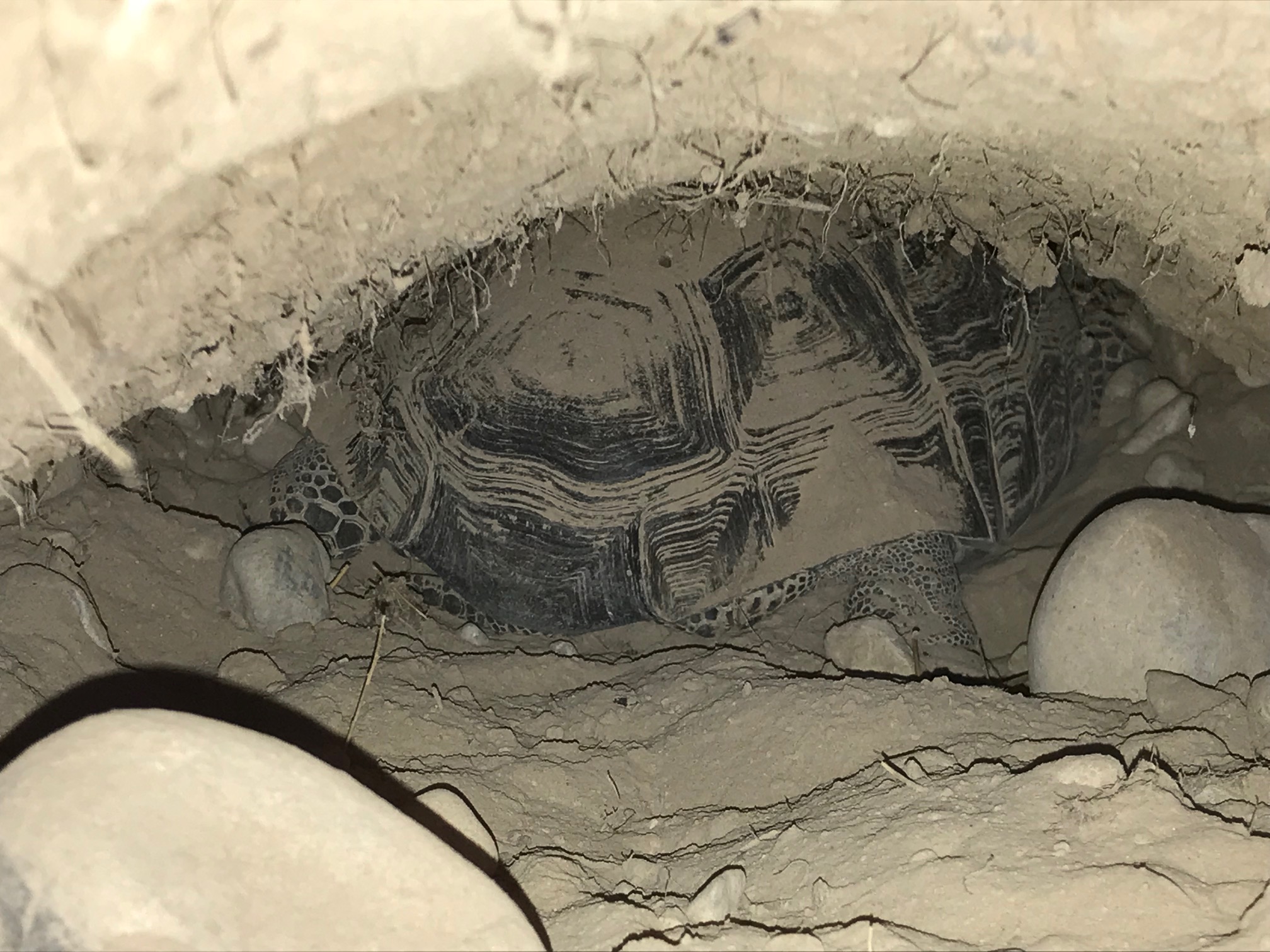
^The desert tortoise (Gopherus agassizii) in its burrow. This is one of the larger tortoises we have ever seen. Please do not approach tortoises or harass them (they are Federally Threatened)--we used a telephoto lens and left this desert reptile alone.
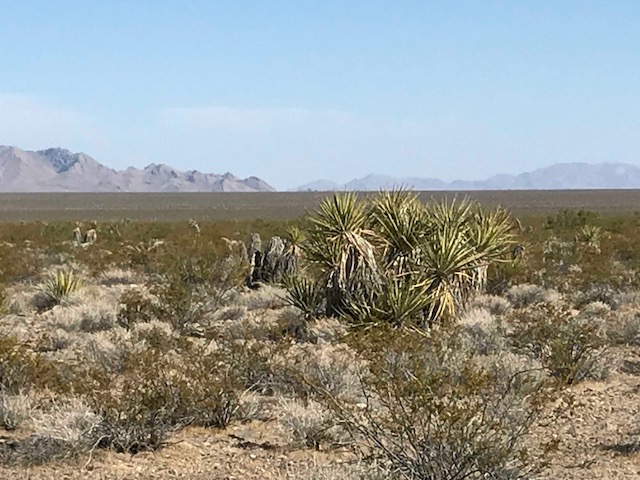
^Mojave yuccas, creosote, and bursage on the proposed project site, looking south towards Clark Mountain and the Stateline Hills. South Pahrump Valley, Nevada.
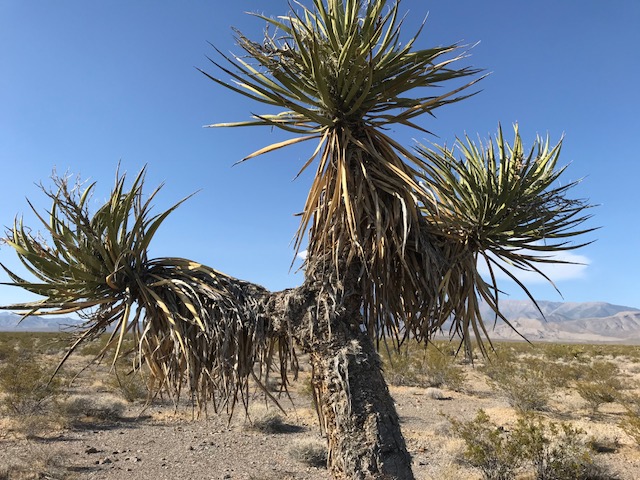
^Tall Mojave yucca.
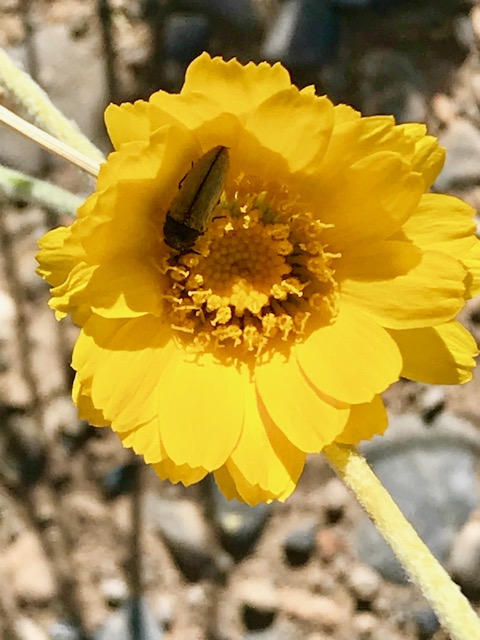
^Beetle in a Baileya flower (Baileya sp.).
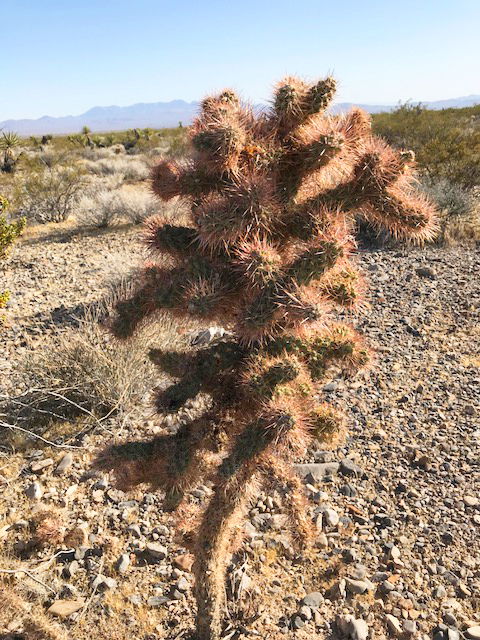
^Silver cholla (Cylindropuntia echinocarpa).

^Paper daisy (Psilotrophe cooperi).
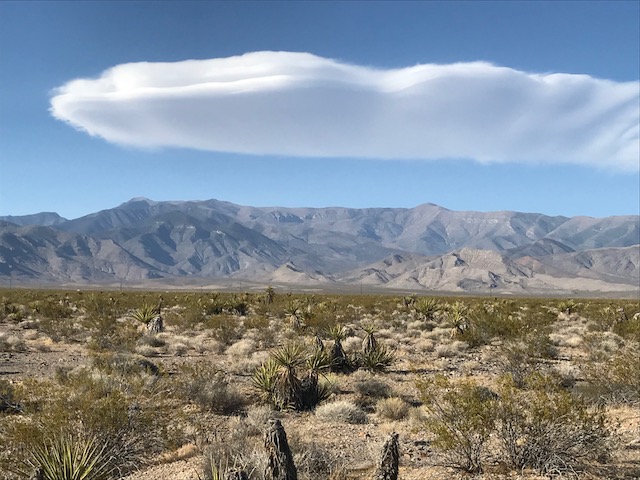
^Lenticular cloud over the Spring Range, seen from the proposed project site.

^Juvenile desert night lizard (Xantusia vigilis) caught and released in a dead Mojave yucca.
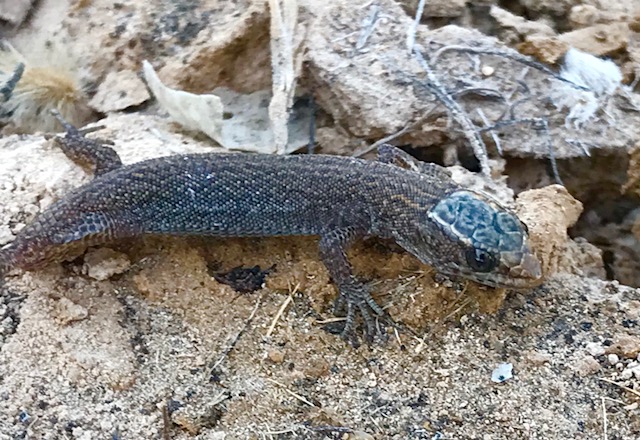
^Close up of the juvenile desert night lizard.
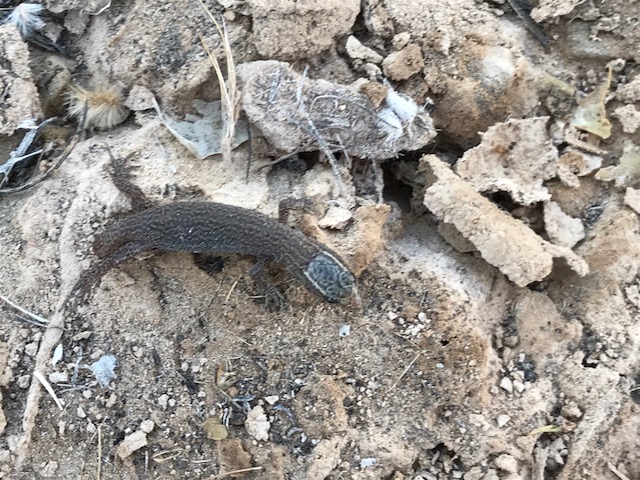
^Juvenile desert night lizard.

^Wash from flash floods coming off of the high Spring Range in the background: the solar project will have problems with placing their photovoltaic panels here.
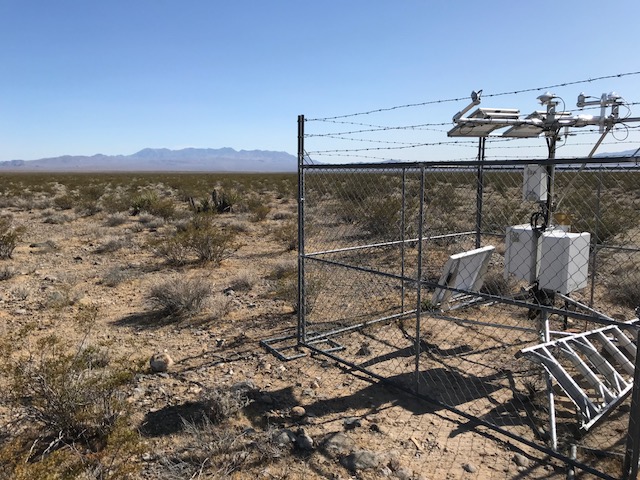
^Meteorological station for the proposed solar project.
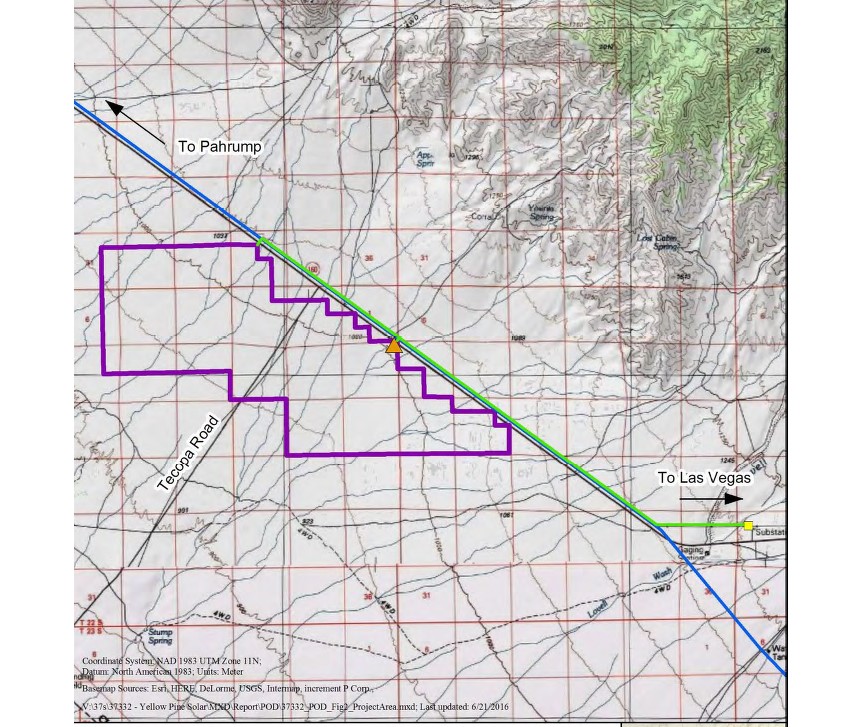
^2018 map of the proposed solar project.
Yellow Pine Solar Project
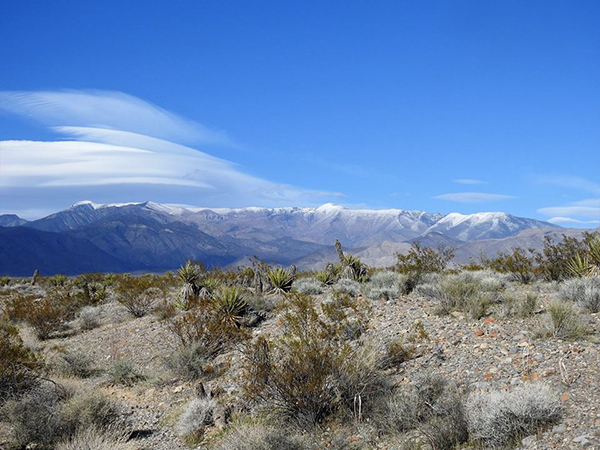
^The project site would be bulldozed for a solar field. Spring Range in the background.
March 26, 2018 - Pahrump Valley NV - The Bureau of Land Management, Nevada, will officially start the review of the Yellow Pine Solar Project in a fewweeks. There will be a Federal Register notice asking for comments on this photovoltaic facility which would be built in the southern Pahrump Valley on top of the Old Spanish Trail. The project would be constructed on up to 3,000 acres and will have a lithium ion battery storage element on site. The transmission will go through Boulder City, Nevada to Southern California. If built, a very large unbroken landscape in this part of the Mojave Desert will be fragmented. It will be located right in the center of a recently approved desert tortoise translocation area. If tortoises are moved here, does it make sense to later bulldoze the habitat for solar panels?
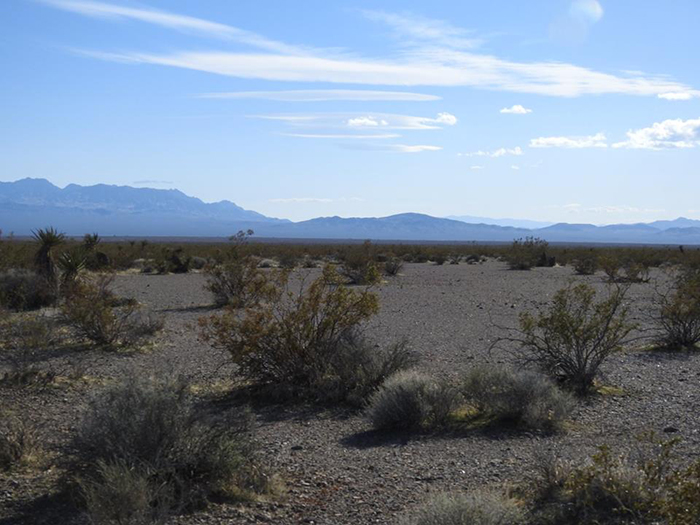
^Sensitive natural desert pavement on the proposed project site. Kingston Range in the distance.

^Yellow Pine Solar Project proposed site to be bulldozed, with the Spring Range as the backdrop.
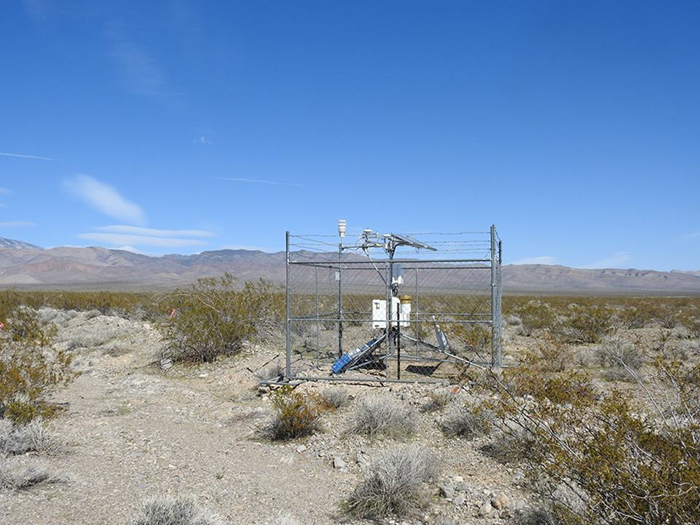
^Weather station on the proposed project site, by NextEra.
Desert Tortoises and Mojave Yuccas Threatened by Utility-scale Solar: Yellow Pine Solar Project
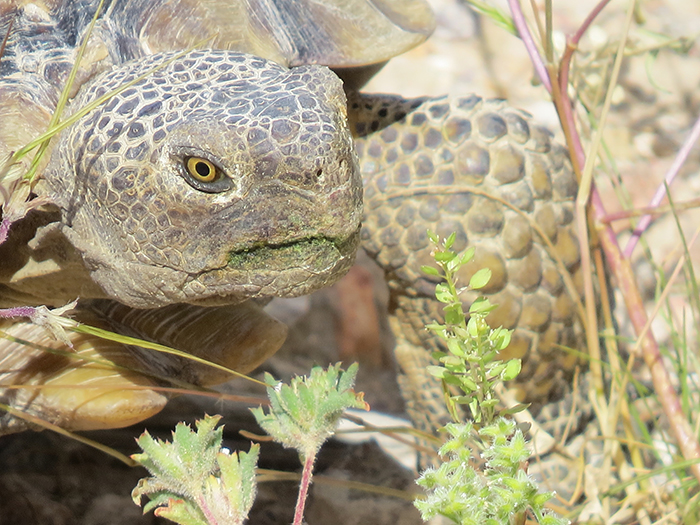
^Female Desert tortoise dining on spring greens in the Mojave Desert of Nevada.
July 8, 2016 -- South of Pahrump, NV -- Laura Cunningham and Kevin Emmerich -- On June 26 NextEra filed an application with the Public Utilities Commission of Nevada for a new 250 megawatt photovoltaic project proposed for Mojave Desert ecosystems with old growth yucca stands in Pahrump Valley along the Tecopa Road and close to the historic Old Spanish Trail.
But conflicts exist with land management here. This area was created to move tortoises out of harms way and to release tortoises that have been picked up or once have been pets. The Las Vegas, Nevada Desert Tortoise Conservation Center was closed in 2014 by the US Fish and Wildlife Service due to budget cuts. So these tortoises are tested for disease and released in the Pahrump Valley on two "translocation areas", Trout Canyon and Stump Springs designated last year. Now (July, 2016) the Bureau of Land Management will consider approving the Yellow Pine Solar Project on about 3,000 acres of this translocation site.
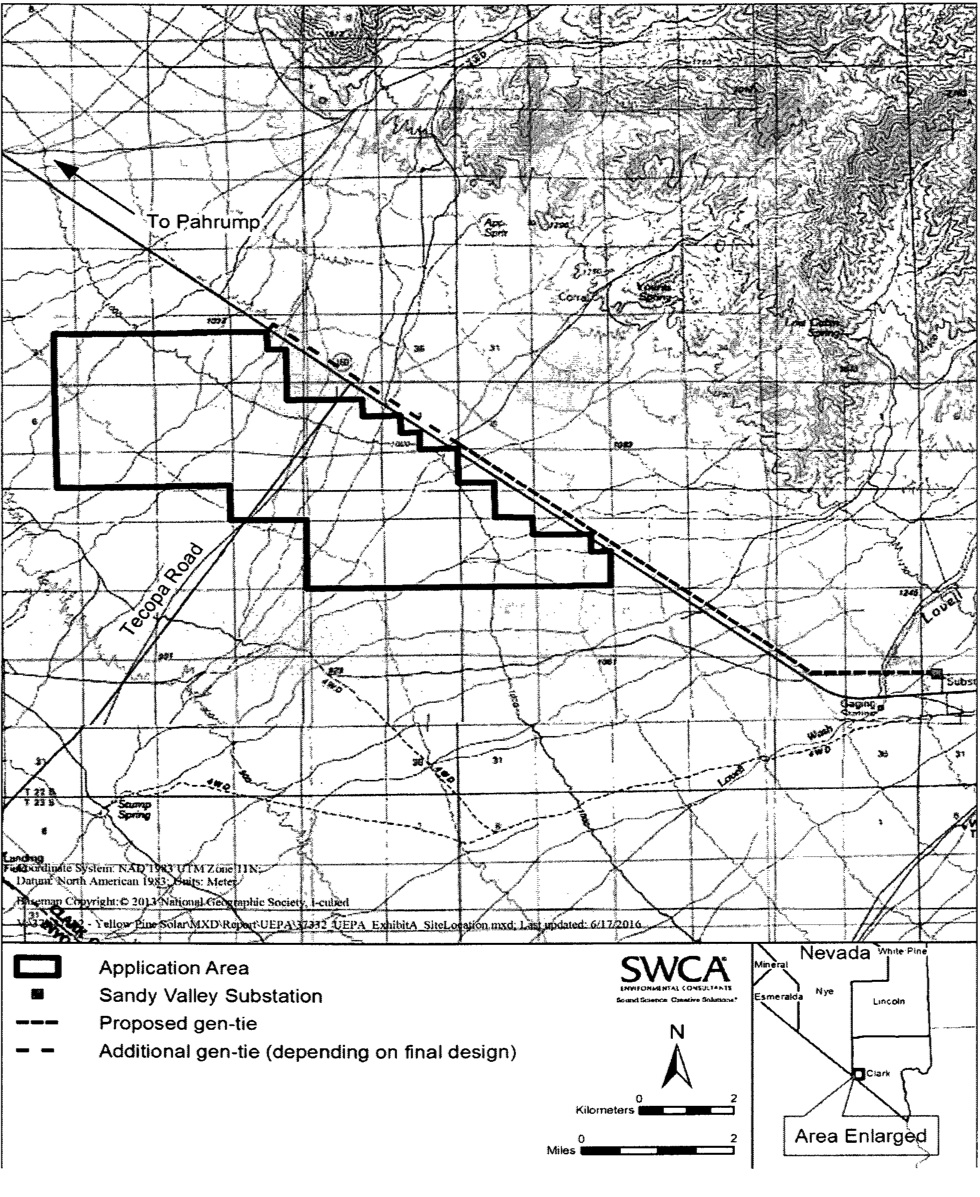
^Yellow Pine Solar Project proposal map, overlapping important tortoise translocation and connectivity habitat, and old growth Mojave yuccas.
This project would be built on a recently approved desert tortoise translocation area. When the Desert Tortoise Conservation Center (DTCC) in Clark County, Nevada, was closed down a place was needed to translocate all of those soon to be homeless tortoises. Now all the translocated tortoises would be moved again and disturbed further if this project were approved. There was an Environmental Assessment by the Bureau of Land Management on this translocation from the Las Vegas area DTCC, to Pahrump Valley, and a Stump Springs Translocation Plan. This should be a solar-free zone to keep this important tortoise habitat intact.
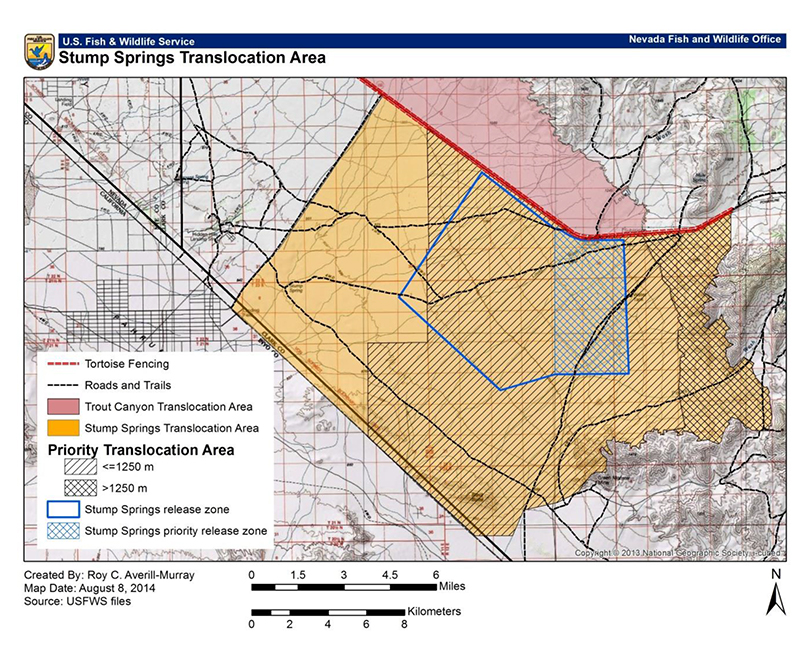
^Translocation map for desert tortoises moved from the Desert Tortoise Translocation Center, showing overlap with Yellow Pine Solar Project proposed map (top of page above). Will tortoises have to be moved again? From the Stump Springs Translocation Plan.
In the Solar Programmatic Environmental Impact Statement this area was called Variance Avoidance land, which needed full environmental review. But this Yellow Pine Solar Project was grandfathered in as it was bought from an older previous project applicant (Boulevard Associates).
The proposed project site is less than a quarter mile from one of the tallest Mojave yuccas (Yucca schidigera) yet found. The project site itself contains numerous Mojave yuccas and Joshua trees, as well as healthy undisturbed Mojave Desert scrub.
Numerous large washes cut through the proposed project site, which could impact photovoltaic panels if flash floods come off the tall Spring Range.
The Yellow Pine Solar Project would be a single-axis tracking solar photovoltaic project built by NextEra on pristine desert on up to 3,000 acres of Bureau of Land Management land in Nevada near the Old Spanish Trail Road right next to the Old Spanish Trail and the Stump Spring Area of Critical Environmental Concern. This is the first notice with the Nevada Public Utilities Commission. This is very old-growth Mojave Desert with ancient creosote rings, desert tortoise and very tall Mojave yuccas. It is close to the old Hidden Hills Solar Project which was recently defeated. Solar panels should go on rooftops, or the many hundreds of acres of old degraded agricultural land within Pahrump that are right now unused. More information here:
http://clearinghouse.nv.gov/public/Notice/2016/E2016-170.pdf
(http://pucweb1.state.nv.us/PUC2/DktDetail.aspx) -- link stopped working
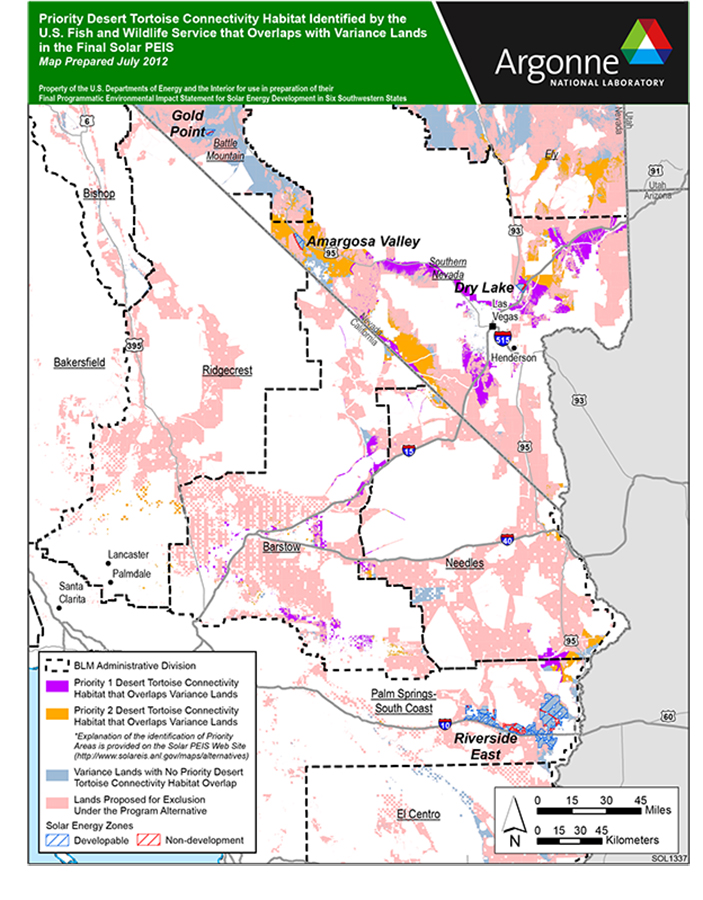
^US Fish and Wildlife Service map showing connectivity habitat for allowing the continuance of genetic flow through the desert. Ivanpah Valley has already been critically blocked with utility-scale solar projects, will Pahrump and Sandy valley be next?
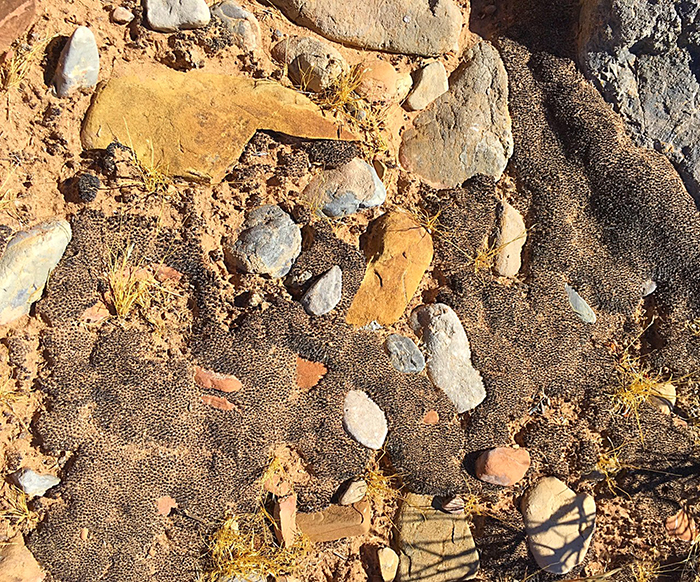
^Thick moss growing on shadier north-facing edges of large wash banks.

^Large wash with three-foot tall banks draining across the alluvial fan from the Spring Range. Several such large washes cut through the proposed project site.
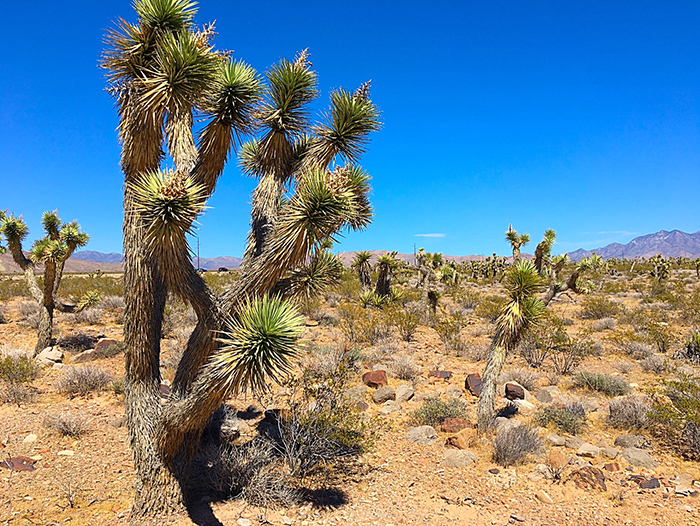
^Beautiful Joshua tree woodland in this same area.
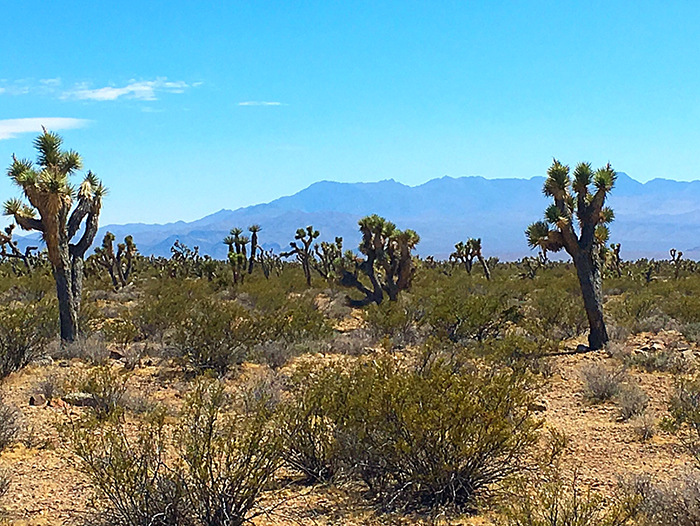
^The tall Mojave yucca in the background among similar-sized Joshua trees. The Kingston Range is in the background.
^Near the proposed project site, looking eastward towards to Spring Range, in the Stump Springs Desert Tortoise Translocation area.
HOME.....Hidden Hills Solar Project.....Stump Springs.....Copper Rays Solar Project.....Rough Hat Nye and Clark Solar Projects.....Golden Currant Solar Project
